10 The Wonder Years
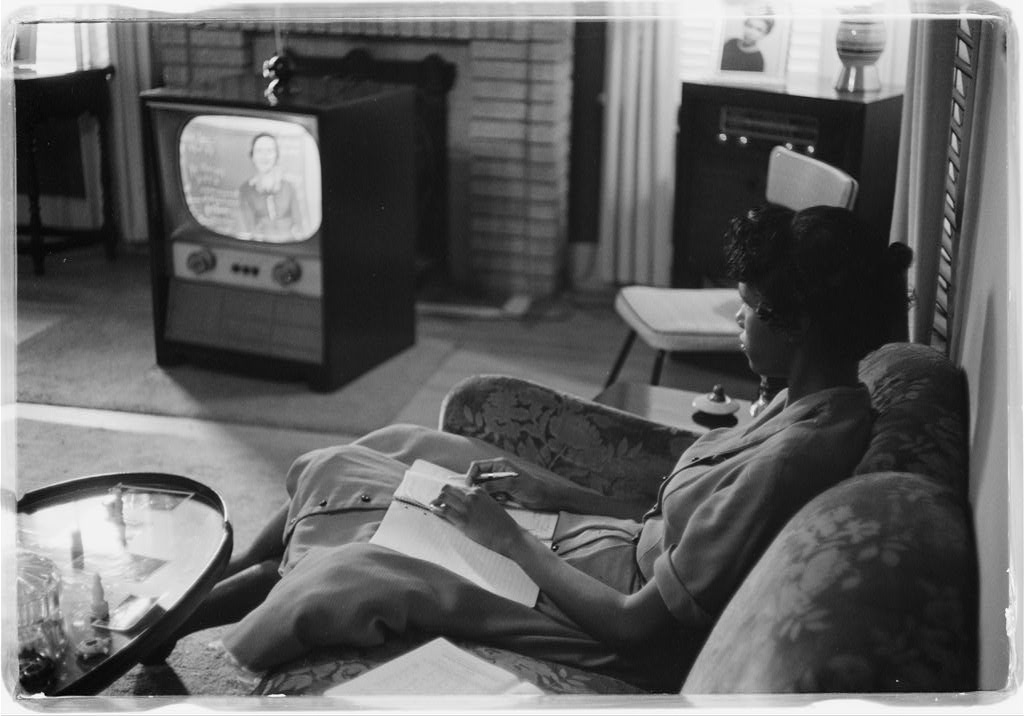
Affluent Society
In 1958, Harvard economics professor John Kenneth Galbraith published a book called The Affluent Society that examined America’s new post–World War II consumer economy and political culture. Galbraith noted the unparalleled riches produced by American economic growth in the postwar years, but he criticized what he saw as an economy dedicated only to increasing production and consumption of goods. Galbraith argued that America’s almost hedonistic culture of consumerism would inevitably lead to economic inequality. Galbraith warned that an economy dominated by the marketing of consumer products where “wants are increasingly created by the process by which they are satisfied” was unsound, unsustainable, and, ultimately, immoral. While economists and historians debate the merits of Galbraith’s warnings and predictions, his analysis resonated and the title of his book came to serve as a label for postwar American society. In the two decades after the end of World War II, the American economy witnessed massive and sustained growth that reshaped American culture through the abundance of consumer goods. Standards of living across all income levels climbed to unparalleled heights and economic inequality plummeted.
And yet, as Galbraith noted, the Affluent Society had fundamental flaws. Consumerism distracted Americans from the ongoing tensions of the Cold War. The economic growth that lifted millions of Americans into the middle class also reproduced existing inequalities. Women struggled to claim equal rights as full participants in American society. The poor struggled to win access to good schools, good healthcare, and good jobs. The suburbs that gave many middle-class Americans a new lifestyle left cities withering in spirals of poverty and crime. The Jim Crow South tenaciously defended segregation, but throughout America blacks and other minorities suffered discrimination and had fewer options to improve their lives. The contradictions of the Affluent Society defined the decade: unrivaled prosperity alongside persistent poverty, expanded opportunity alongside entrenched discrimination, and new liberating lifestyles alongside a stifling conformity.
As transportation networks improved in the late nineteenth and early twentieth centuries, it became increasingly practical for people who worked in cities to commute to their jobs. Residential suburbs began to appear along railway lines and later along highways. Unlike the older satellite towns that had once supplied cites with food and had traditionally been economically self-contained, suburbs were mainly residential. Suburban economies generally depended upon the consumption spending of residents who earned their incomes in nearby cities.The first suburban developments in America were New York City’s bedroom communities in Westchester County. Originally a rural area along the Hudson River north of the city, Westchester became a weekend retreat for wealthy New Yorkers toward the end of the nineteenth century. When convenient rail service from Grand Central Station made it practical for commuters to leave the city every night, real estate developers began building residential communities for affluent city workers. Soon middle and even some working-class New Yorkers began following the examples of their bosses and managers; moving their families to suburbs such as New Rochelle.
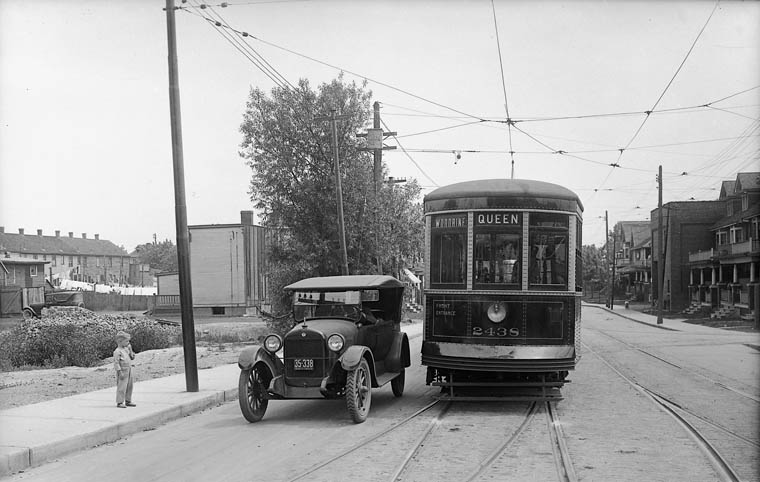
After World War II, prosperity and growth created opportunities that had not been available during the Great Depression and the war years. A rapidly-expanding American middle class looked for a place of their own in the suburbs. The pent-up demand of homebuyers who had been delayed by the Great Depression and young people eager to start families and get on with their lives after the war years further accelerated suburban growth. The GI Bill and New Deal financial reforms made home ownership accessible to more people than ever before.
At the height of the Great Depression, in 1932, some 250,000 households had lost their homes to foreclosure. A year later, half of all U.S. mortgages were in default. The foreclosure rate stood at more than one thousand per day. In response, Franklin Roosevelt created the Home Owners’ Loan Corporation (HOLC), which began purchasing and refinancing existing mortgages at risk of default. The HOLC introduced the amortized mortgage, allowing borrowers to pay back interest and principal regularly over fifteen or more years. Previously mortgage loans had only lasted five years and had carried large balloon payments at the end of the contract. The HOLC eventually owned nearly one of every five mortgages in America. Though homeowners paid more for their homes under this new system, the cost was spread over a much longer period, so monthly payments were much more affordable. With mortgage payments often lower than monthly rents, home ownership was opened to multitudes who gained residential stability and began to accrue wealth as property values rose over time. The family home became most Americans’ most significant investment.
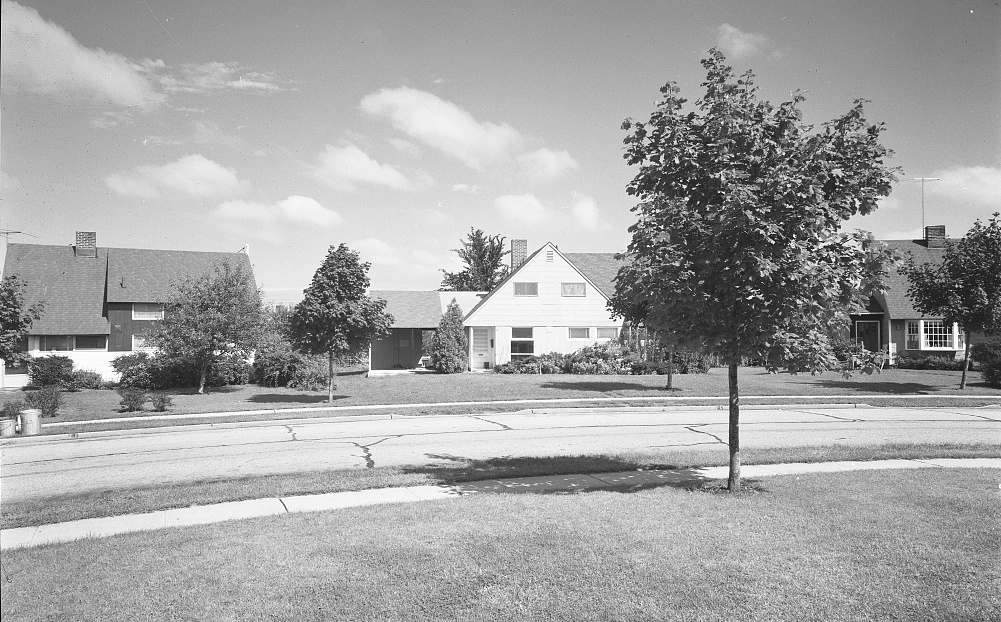
Additionally, the Federal Housing Administration (FHA), another New Deal organization, increased access to home ownership by insuring mortgages and protecting lenders from financial loss in the event of a default. In order to qualify as an FHA lender, a bank had to offer low interest rates and terms of up to thirty years. These changes allowed even more consumers to afford homes. And although only about a third of homes had an FHA-backed mortgage by 1964, FHA loans had a ripple effect. In order to compete, private lenders granted more home loans on similar terms even to non-FHA-backed borrowers. Government programs and subsidies like the HOLC and the FHA fueled the growth of home ownership, a wave of new house construction, and the rise of the suburbs.
Questions for Discussion
- Why did Americans move to the suburbs in the 1950s?
- How did the U.S. government make it easier for people to buy homes?
Government spending in the New Deal and during World War II pushed the United States out of the Depression and into an economic boom that was sustained after the war by continued government spending. Government expenditures provided loans to veterans, subsidized corporate research and development, and built the interstate highway system. Without paved roads to run on, there would have been far fewer cars and trucks built and sold in America, and their impact on society and the environment would have been much different. The biggest road-building project in American history was the construction of the interstate highway system, financed by the Federal-Aid Highway Acts of 1944 and 1956. The system’s construction was paid for by the federal government and the roads were owned by the states. The system included nearly 47,000 miles of highway, and the project was designed to be self-liquidating, so that the cost of building highways did not contribute to the national debt. In addition to the interstate system, American states, counties, cities and towns maintain systems of roads totaling nearly four million miles, about two-thirds of which are paved.
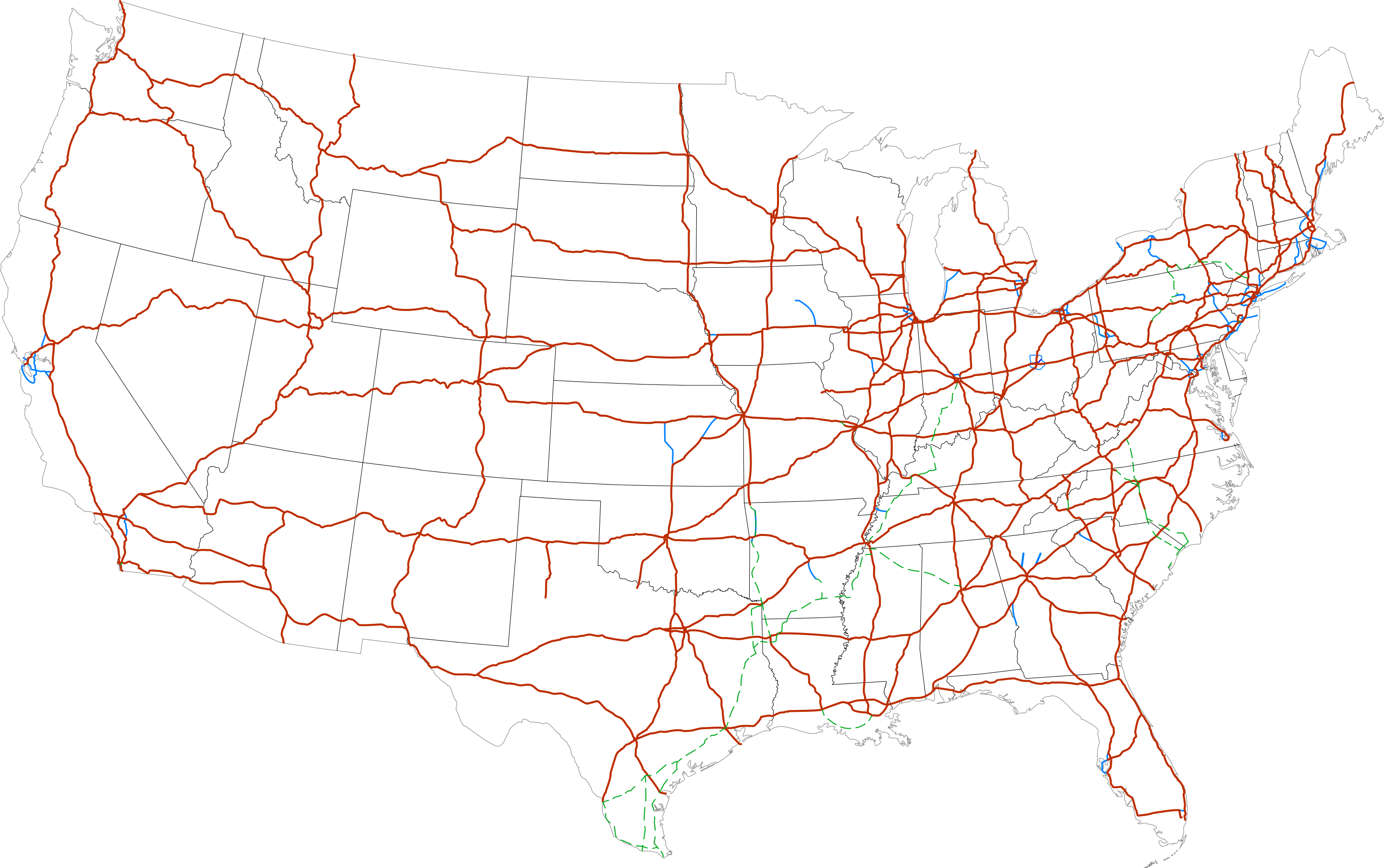
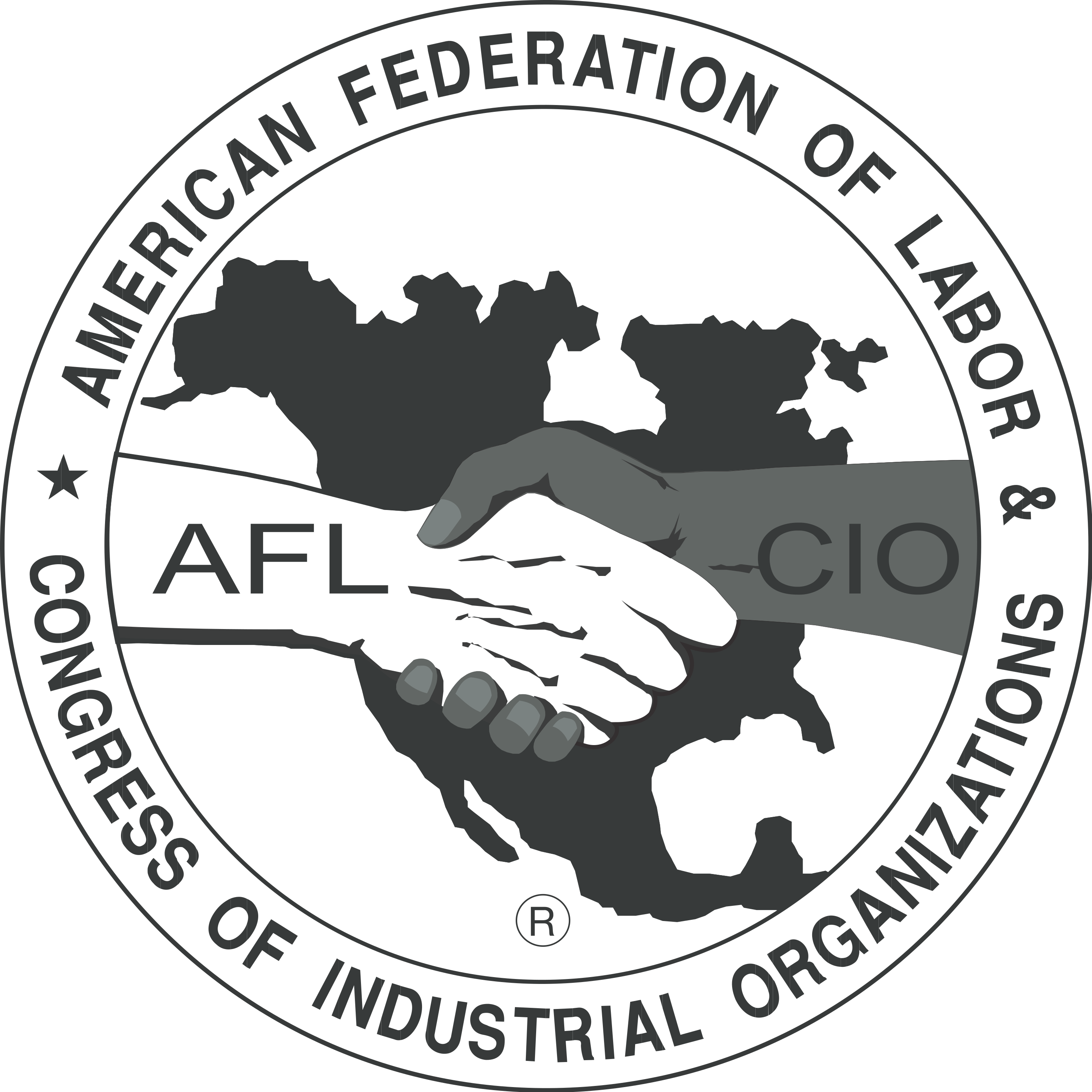 In the decades after World War II, business boomed, unionization peaked, wages rose, and sustained growth buoyed a new consumer economy. The American Federation of Labor (AFL) and the Congress of Industrial Organizations (CIO) merged into the AFL-CIO in 1955, and membership peaked in 1979 at nearly twenty million. After the success of its sit-down strikes in the 1930s, the United Auto Workers became a force in Detroit, striking General Motors for 113 days in 1945. The International Brotherhood of Teamsters, whose members were not only truckers but workers in building trades, food processing, and media, grew from 146,000 in 1935 to a million in 1949 and 2 million in 1976. The strength of unions in fighting for better wages, hours, and benefits allowed many of their blue-collar members to enter the middle class alongside white-collar professionals. Finally, the Servicemen’s Readjustment Act, popularly known as the G.I. Bill, offered low-interest home loans, a stipend to attend college, loans to start a business, and unemployment benefits. By 1956, when the original 1944 bill lapsed, nearly 8 million veterans had received educational benefits that allowed them to enter the professional or skilled labor workforce. Similar programs were enacted for Korean and Vietnam veterans.
In the decades after World War II, business boomed, unionization peaked, wages rose, and sustained growth buoyed a new consumer economy. The American Federation of Labor (AFL) and the Congress of Industrial Organizations (CIO) merged into the AFL-CIO in 1955, and membership peaked in 1979 at nearly twenty million. After the success of its sit-down strikes in the 1930s, the United Auto Workers became a force in Detroit, striking General Motors for 113 days in 1945. The International Brotherhood of Teamsters, whose members were not only truckers but workers in building trades, food processing, and media, grew from 146,000 in 1935 to a million in 1949 and 2 million in 1976. The strength of unions in fighting for better wages, hours, and benefits allowed many of their blue-collar members to enter the middle class alongside white-collar professionals. Finally, the Servicemen’s Readjustment Act, popularly known as the G.I. Bill, offered low-interest home loans, a stipend to attend college, loans to start a business, and unemployment benefits. By 1956, when the original 1944 bill lapsed, nearly 8 million veterans had received educational benefits that allowed them to enter the professional or skilled labor workforce. Similar programs were enacted for Korean and Vietnam veterans.
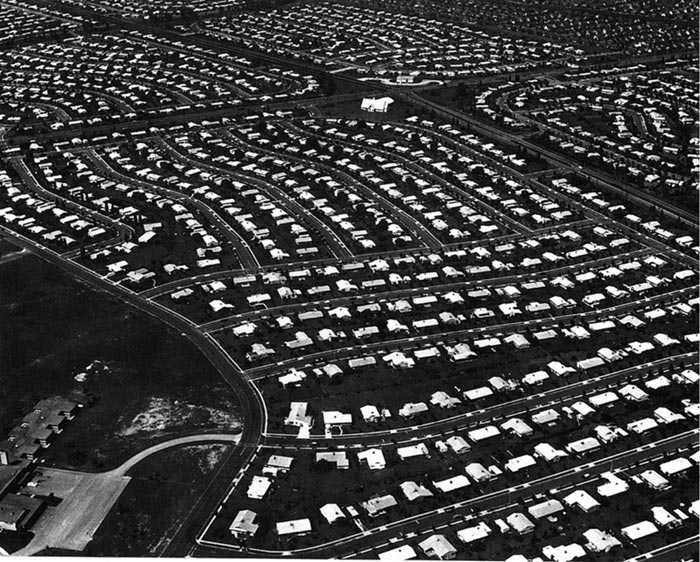
The rapid growth of home ownership and the rise of suburban communities helped drive the postwar economic boom. As demand for homes rapidly overwhelmed existing housing, builders created sprawling neighborhoods of single-family homes on the outskirts of American cities. Suburbs like Levittown, a development of over 17,000 affordable, ranch-style homes about fifty miles from Manhattan, sprang up along rail lines and highways close to major cities. Purchasing large acreage, subdividing lots, and contracting crews to build countless homes at economies of scale, William Levitt built the first Levittown on Long Island in 1946. Using FHA and VA mortgages, Levittown offered affordable suburban housing to veterans and their families. Levitt became the prophet of the new suburbs, beginning a second Levittown in Pennsylvania in 1952 and building five more in Maryland, New Jersey, and even Puerto Rico between the 1950s and 1970. Levitt’s model of large-scale suburban development was duplicated by developers across the country and the suburban share of the American population rose from 19.5 percent in 1940 to 30.7 percent by 1960. Home ownership rates rose from 44 percent in 1940 to almost 62 percent in 1960. Between 1950 and 1970, America’s suburban population nearly doubled to seventy-four million. Eighty-three percent of all population growth occurred in the ‘burbs. Suburban zoning laws controlled the placement of commercial and residential buildings, creating a separation not seen in cities and heightening residents’ reliance on automobiles to reach shopping, entertainment, and recreational facilities. Suburban families increasingly depended on their cars not only to get to work in the cities, but to visit shopping centers and malls, to get to bowling allies and the movies, and to get the kids to school, little league, or band practice. Many families acquired a second car, and then sometimes another for teenage children. Today, there are 250 million automobiles in America; substantially more than the number of licensed drivers.
Questions for Discussion
- What was the relationship between transportation and affluence?
- How was the interstate highway system different from the railroads of the nineteenth century?
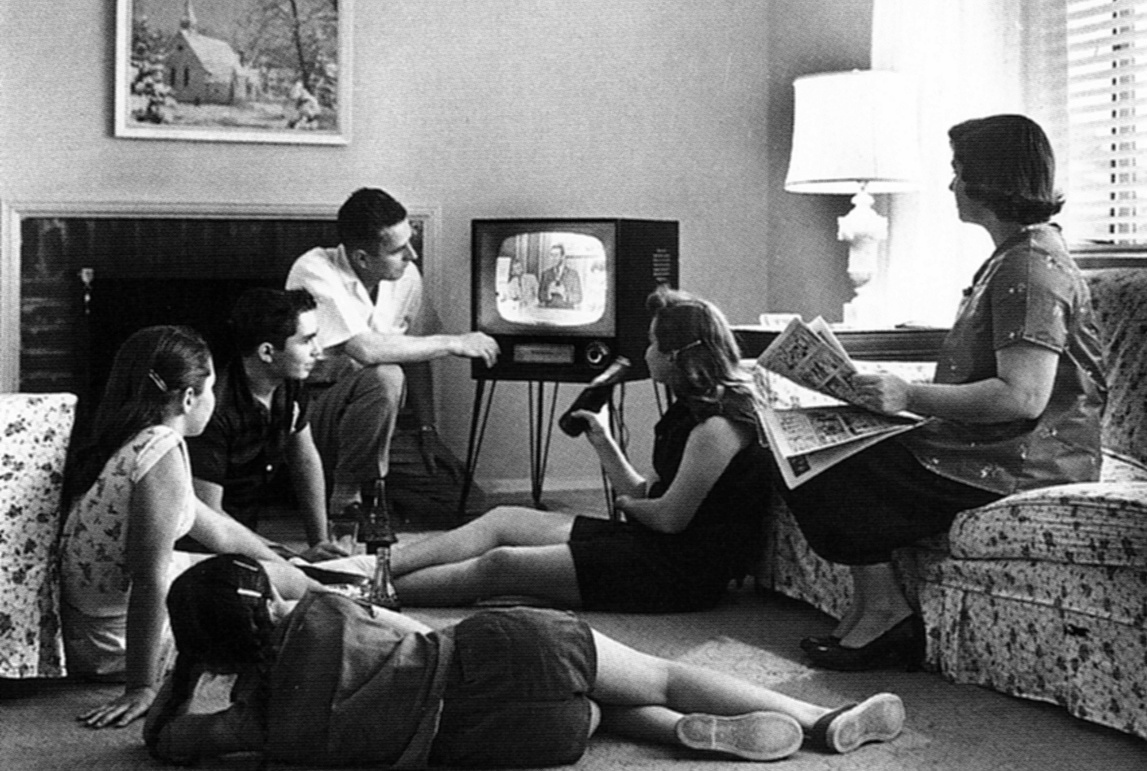
The postwar construction boom fed into countless industries. As manufacturers converted from war materials back to consumer goods, and as the suburbs developed, homeowners also used newly created installment plans to buy new consumer goods at once instead of saving for years to make major purchases. Credit cards, first issued in 1950, further increased access to credit. No longer held back by the Depression or wartime restrictions, consumers bought countless washers, dryers, refrigerators, freezers, and, suddenly, televisions. The percentage of Americans that owned at least one television increased from 12 percent in 1950 to more than 87 percent in 1960. On the surface, the postwar economic boom turned America into a land of abundance. For both blue-collar and white-collar middle-class buyers, loans had never been easier to obtain, consumer goods had never been more accessible, and well-paying jobs had never been more abundant. And many Americans were able to take advantage of work experience and education to enter the expanding ranks of management. “If you had a college diploma, a dark suit, and anything between the ears,” one businessman later recalled, “it was like an escalator; you just stood there and you moved up.” But the escalator did not serve everyone equally. Beneath the broadly positive aggregate numbers showing social progress, racial disparity, sexual discrimination, and economic inequality persevered, undermining some of the main assumptions of an Affluent Society.
Wealth created by the booming economy filtered through social structures with longstanding, built-in privileges and prejudices. Just when many middle- and working-class white American families began their journey of upward mobility by moving to the suburbs with the help of government programs such as the FHA and the G.I. Bill, African Americans and other racial minorities often found themselves systematically shut out. Many of the new suburban enclaves, including Levittown, were built for white families only. Developers refused to sell homes to black buyers, believing real estate values would be depressed in racially mixed neighborhoods. And the relationship between federal organizations such as the HOLC, the FHA, and private banks, lenders, and real estate agents allowed standardized policies that produced a segregated housing market. At the core of HOLC appraisal techniques, used by private real estate agents, was the assumption that mixed-race and minority-dominated neighborhoods were credit risks. In partnership with local lenders and real estate agents, the HOLC created Residential Security Maps to identify high-risk lending areas, which were outlined in red ink. Banks limited loans in such “redlined” areas.
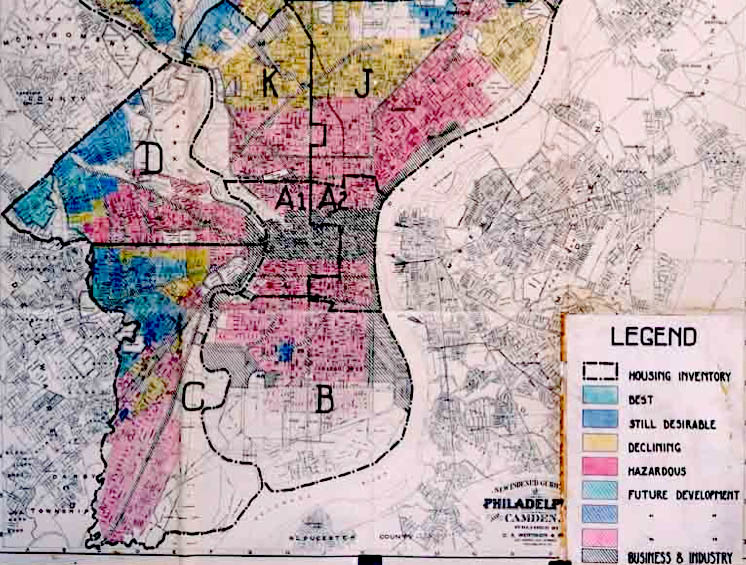
Phrases like subversive racial elements and racial hazards pervaded the redlined-area descriptions of surveyors and HOLC officials. While the HOLC was a fairly short-lived New Deal agency, the influence of its security maps lived on in the FHA and Veterans Administration (VA), which dispensed G.I. Bill–backed mortgages. Both of these government organizations reinforced the standards followed by private lenders, refusing to back bank mortgages in “redlined” neighborhoods. Racial minorities could not get loans for property improvements in their own neighborhoods and were denied mortgages to purchase property in other areas where their presence would extend the red line into a new community. Although the government programs did allow millions of Americans to receive mortgages who would otherwise have been unable to buy a home, FHA and VA policies and private developers increased home ownership and stability for white Americans while simultaneously creating and enforcing racial segregation.
Questions for Discussion
- How did consumer credit propel growth?
- Why was redlining a problem?
Race and Civil Rights
Older battles over racial exclusion also confronted postwar American society. One long-simmering struggle targeted segregated schooling. In 1896, the Supreme Court’s Plessy v. Ferguson decision had declared the principle of “separate but equal” constitutional. Segregated schooling, however, was rarely “equal” in practice. Black Americans, particularly in the South, received fewer funds for their schools, attended inadequate facilities, and studied with substandard materials. African Americans’ quiet battle against educational inequality continued for half a century before the Supreme Court again took up the question of “separate but equal.”
On May 17, 1954, after two years of argument and deliberation, Chief Justice Earl Warren announced the Supreme Court’s decision on segregated schooling in Brown v. Board of Education. The court found by a unanimous 9–0 vote that racial segregation violated the Equal Protection Clause of the Fourteenth Amendment. The court’s decision declared, “Separate educational facilities are inherently unequal.” Though remembered as just one lawsuit, Brown v. Board of Education consolidated five separate cases that had originated in the southeastern United States: Briggs v. Elliott (South Carolina), Davis v. County School Board of Prince Edward County (Virginia), Beulah v. Belton (Delaware), Boiling v. Sharpe (Washington, D.C.), and Brown v. Board of Education (Kansas). Working with local activists already involved in desegregation fights, the NAACP had purposely chosen cases with a diverse set of local backgrounds to show that segregation was not just an issue in the Deep South, and that a sweeping judgment on the fundamental constitutionality of Plessy was needed. Briggs v. Elliott, the first case accepted by the NAACP, illustrated the plight of segregated black schools. Briggs originated in rural Clarendon County, South Carolina, where taxpayers in 1950 spent $179 to educate each white student and $43 for each black student. The district’s twelve white schools were cumulatively worth $673,850; the value of its sixty-one black schools (mostly dilapidated, overcrowded shacks) was $194,575. While Briggs underscored the South’s failure to follow Plessy, the Brown suit focused less on material disparities between black and white schools and more on the social and spiritual degradation that accompanied legal segregation. This case cut to the basic question of whether “separate” was itself inherently unequal. Identifying and denouncing injustice, though, is different from rectifying it.
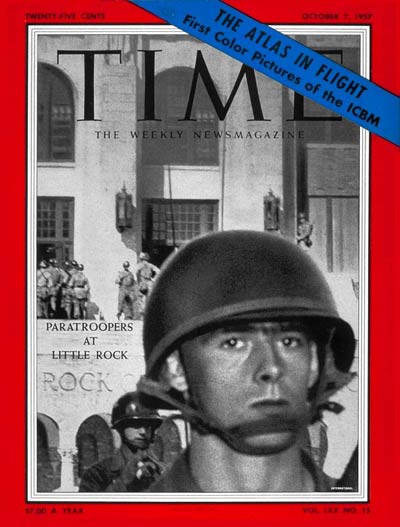
Though Brown repudiated Plessy, the Court’s orders did not extend to segregation in places other than public schools and, even then, to get a unanimous decision for such an historically important case, the justices agreed to set aside the divisive yet essential question of enforcement. Their order in 1955 that school districts desegregate “with all deliberate speed” was so vague and ineffectual that it left the actual business of desegregation in the hands of those who opposed it. The Brown decision was tested in 1957 by nine black students in Little Rock, Arkansas. Chosen by the NAACP for their high academic credentials, the “Little Rock Nine” were enrolled in the city’s previously all-white high school. The city government supported integration, but Arkansas governor Orval Faubus called in the state’s National Guard battalion to prevent the students entering the school. As the NAACP had expected, Faubus’s move forced the hand of President Eisenhower, who warned the governor not to defy the Supreme Court. When Faubus persisted, Eisenhower sent in the 101st Airborne and federalized the 10,000-member Arkansas National Guard, which removed it from Faubus’s control. Although the black students were allowed to attend the high school, America’s conflicts over desegregation were only beginning.
And education was just one aspect of the nation’s Jim Crow machinery. Generations of African Americans had been facing racist policies, cultures, and beliefs in all aspects of American life. And while the struggle for black inclusion had few victories before World War II, the war and the Double V campaign for victory against fascism abroad and racism at home led to rising expectations for many African Americans. When persistent post-war racism and racial segregation continued to undercut the promise of economic and social mobility, African Americans began mobilizing on an unprecedented scale against discriminatory social and legal structures.
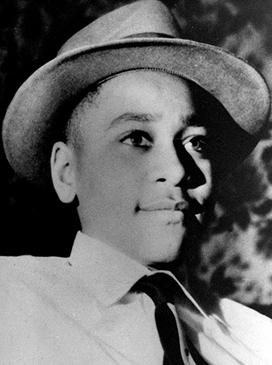
In 1953 an African American woman named Sarah Keys publicly challenged segregated public transportation. Keys, then serving in the Women’s Army Corps, traveled from her army base in New Jersey back to North Carolina to visit her family. When the bus stopped in North Carolina, the driver asked her to give up her seat for a white customer. Her refusal to do so landed her in jail in 1953 and led to a landmark 1955 decision, Keys v. Carolina Coach Company, in which the Interstate Commerce Commission ruled that “separate but equal” violated the Interstate Commerce Clause of the U.S. Constitution. Although the decision was poorly enforced, it nevertheless gave legal coverage for the Freedom Riders years later and motivated further assaults against Jim Crow. But if some events encouraged civil rights workers, others were so savage they convinced activists that they could do nothing but resist. In the summer of 1955, fourteen-year-old Emmett Till, visiting from Chicago and perhaps unfamiliar with the “etiquette” of Jim Crow, allegedly whistled at a white woman named Carolyn Bryant. Her husband, Roy Bryant, and another man, J. W. Milam, abducted Till from his relatives’ home, beat him, mutilated him, shot him, and threw his body in the Tallahatchie River. Emmett’s mother held an open-casket funeral so that her son’s disfigured body could make national news. The white killers were brought to trial. Although the evidence was damning, an all-white jury found the two not guilty. The two boasted of their crime, in all of its brutal detail, in Look magazine. “They ain’t gonna go to school with my kids,” Milam said. They wanted “to make an example of [Till]—just so everybody can know how me and my folks stand.” The Till case became an indelible memory for the young black men and women soon to propel the civil rights movement forward.
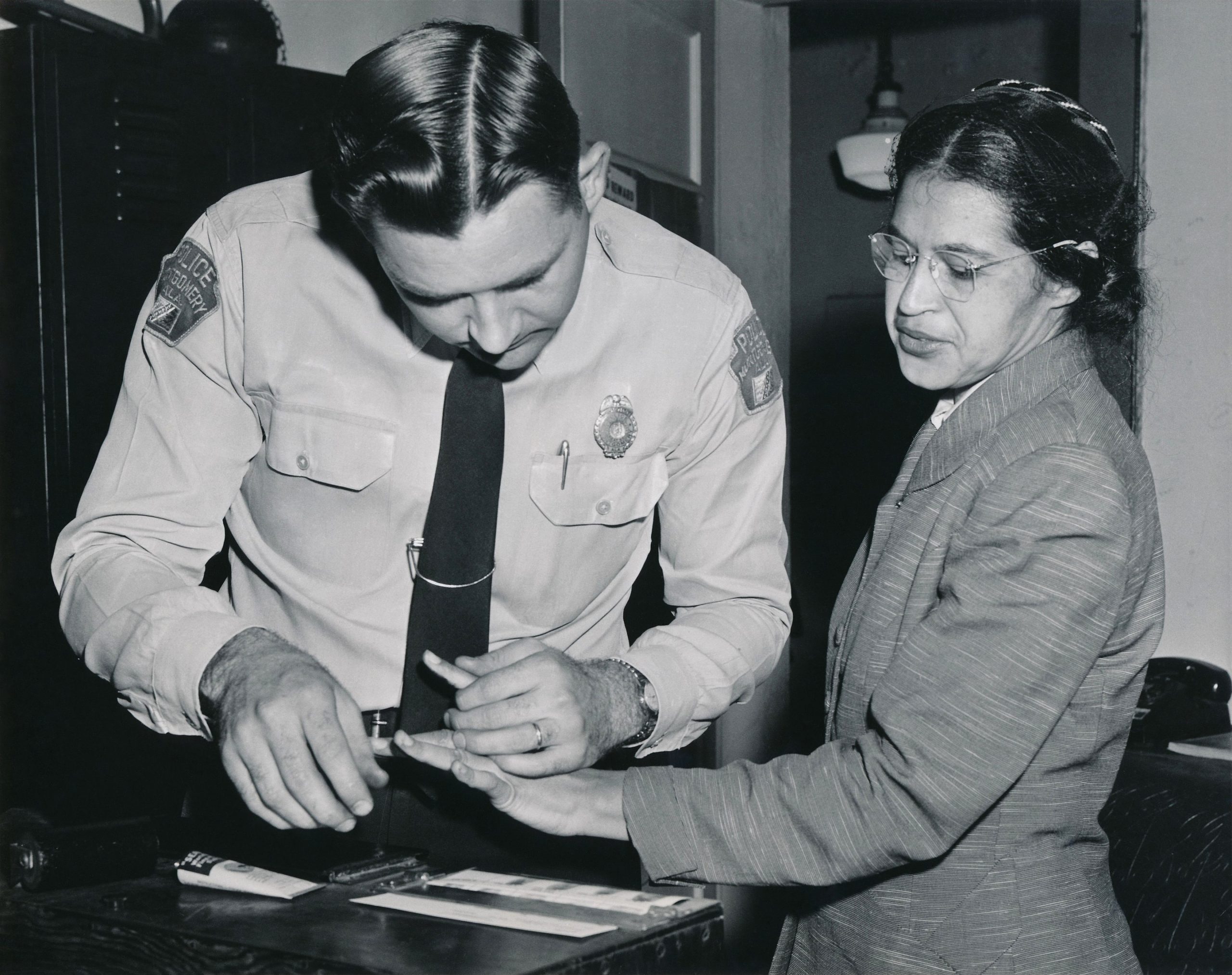
On December 1, 1955, four months after Till’s death and six days after the Keys v. Carolina Coach Company decision, Rosa Parks refused to surrender her seat on a Montgomery city bus and was arrested. Parks was not the first to protest the policy by staying seated, but she was the first around whom Montgomery activists rallied. The city’s black population rallied around the Montgomery Improvement Association, which urged them to boycott the busses. Montgomery Bus Boycott lasted and entire year, from December 1955 until December 1956, when the Supreme Court ordered their integration. The boycott not only crushed segregation in Montgomery’s public transportation, it energized the civil rights movement and established the leadership of the MIA’s president, a twenty-six-year-old Baptist minister named Martin Luther King Jr. In 1957, King helped create the Southern Christian Leadership Conference (SCLC) to coordinate civil rights groups across the South and support their efforts organizing boycotts, protests, and other challenges to southern Jim Crow laws. As pressure built, Congress passed the Civil Rights Act of 1957, the first such measure passed since Reconstruction. The act was weak and filled with compromises, but it did create the Department of Justice’s Civil Rights Commission, to investigate claims of racial discrimination.
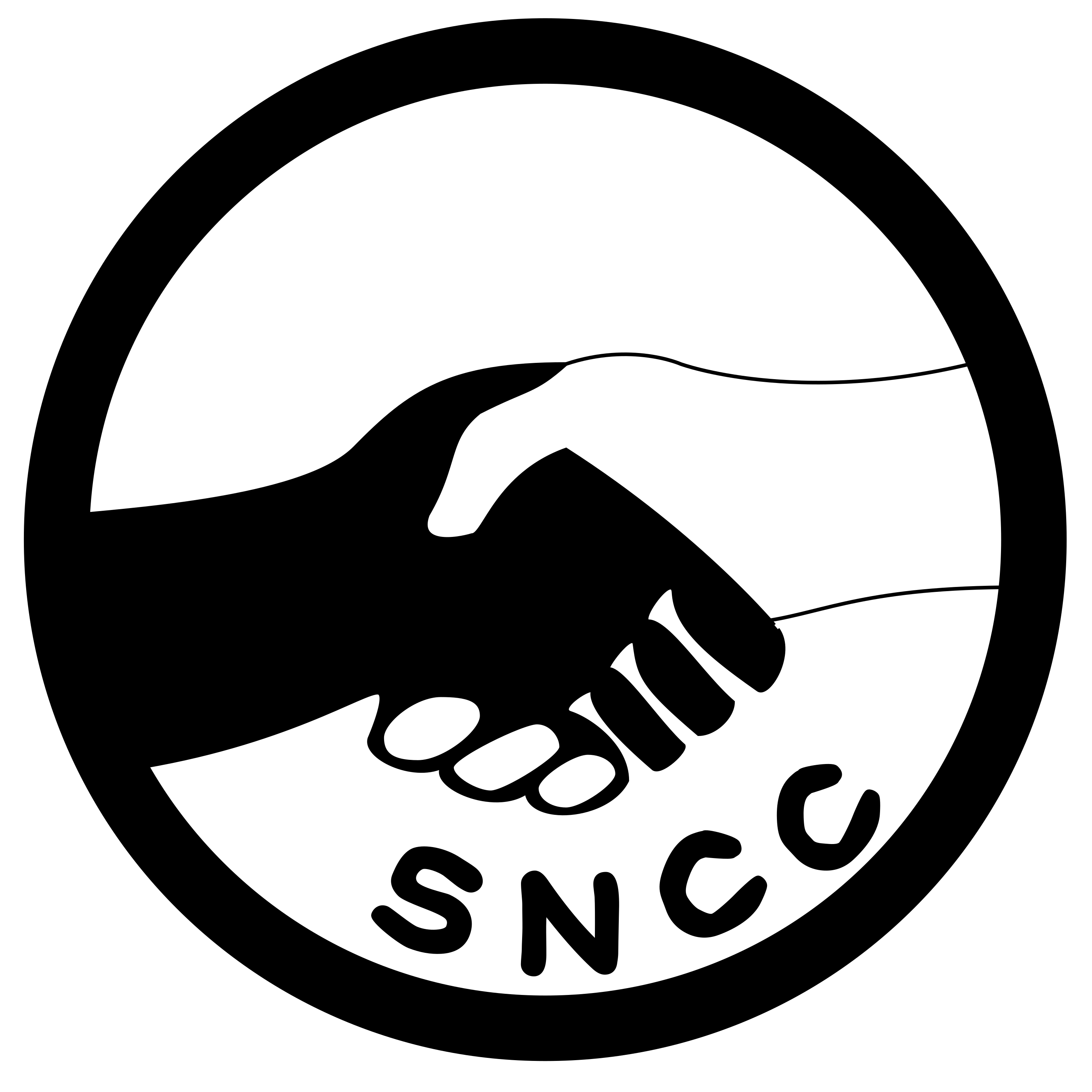 Despite successes at both the local and national level, the civil rights movement faced bitter and often violent opposition. A year into the Montgomery bus boycott, angry white southerners bombed four African American churches as well as the homes of King and fellow civil rights leader E. D. Nixon. On February 1 1960, four college students in Greeensboro North Carolina began a sit-in at the segregated lunch counters of the F.W. Woolworth Company. The lunch counter refused to serve them, and they continued the sit-in protest until July, when the store manager asked four black employees to change into street clothes and sit at the counter, where they were served. By that time, the sit-in movement had spread throughout the South, with more than 2,000 students being arrested in 78 cities and towns. The students formed an organization of their own, the Student Non-violent Coordinating Committee (SNCC), which devoted itself to King’s program of non-violence but called for increasing militance and confrontation of Jim Crow policies.
Despite successes at both the local and national level, the civil rights movement faced bitter and often violent opposition. A year into the Montgomery bus boycott, angry white southerners bombed four African American churches as well as the homes of King and fellow civil rights leader E. D. Nixon. On February 1 1960, four college students in Greeensboro North Carolina began a sit-in at the segregated lunch counters of the F.W. Woolworth Company. The lunch counter refused to serve them, and they continued the sit-in protest until July, when the store manager asked four black employees to change into street clothes and sit at the counter, where they were served. By that time, the sit-in movement had spread throughout the South, with more than 2,000 students being arrested in 78 cities and towns. The students formed an organization of their own, the Student Non-violent Coordinating Committee (SNCC), which devoted itself to King’s program of non-violence but called for increasing militance and confrontation of Jim Crow policies.
Questions for Discussion
- How did race relations change during the 1950s?
- Why were white Americans unwilling to allow their children to go to school with African Americans?
- Was non-violence an effective tactic for Civil Rights activists?
TV Culture
“The American household is on the threshold of a revolution,” the New York Times declared in August 1948. “The reason is television.” Television had first been presented to the American public at the New York World’s Fair in 1939, but commercialization of the new medium in the United States took off after the war years. In 1947, regular full-scale broadcasting became available to the public. Television was instantly popular and between 1948 and 1955 close to two thirds of the nation’s households purchased a television set. By the end of the 1950s, 90 percent of American families had one and the average viewer was tuning in for almost five hours a day. Three big radio broadcasting companies, the National Broadcasting Company (NBC), Columbia Broadcasting System (CBS), and the American Broadcasting Corporation (ABC), used their technical expertise and capital reserves to conquer the television airwaves. They acquired licenses to local stations and eliminated their few independent competitors. The refusal of the Federal Communication Commission (FCC) to issue any new licenses between 1948 and 1955 became a de facto endorsement of the big three’s stranglehold on the market. In addition to replicating radio’s organizational structure, the new television networks also looked to radio for content. Many early programs were adaptations of popular radio variety and comedy shows, including The Ed Sullivan Show and Milton Berle’s Texaco Star Theater. Standard formats were supplemented by live plays, dramas, sports, and situation comedies. Because of the cost and difficulty of recording, most early programs were broadcast live, forcing stations across the country to air shows at the same time. And since audiences had a limited number of channels to choose from, viewing experiences were broadly shared. More than two thirds of television-owning households, for instance, watched popular shows such as I Love Lucy.
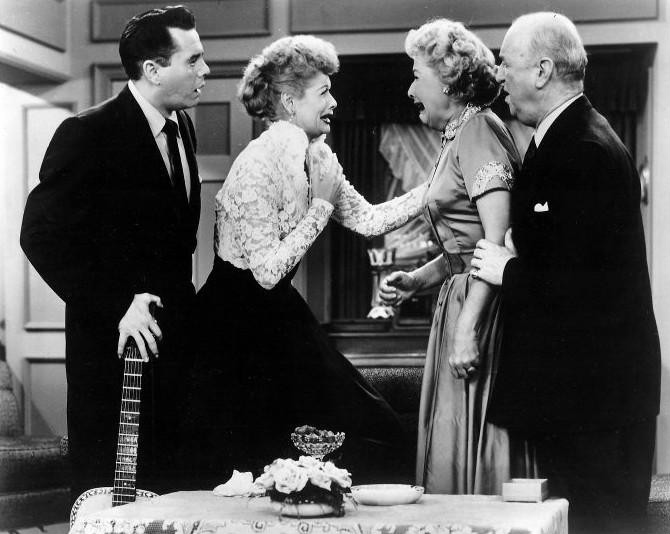
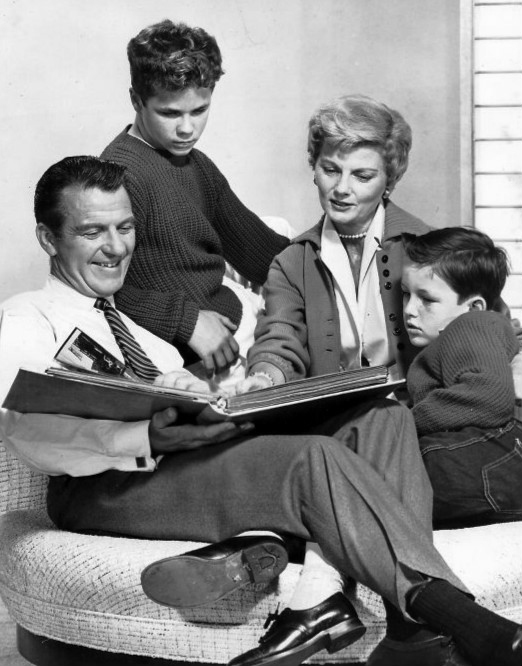
The limited number of channels and programs meant that networks selected programs that appealed to the widest possible audience to draw viewers for their advertisers, television’s greatest financers. By the mid-1950s, an hour of primetime programming cost about $150,000 (about $1.5 million in today’s dollars) to produce. This proved too expensive for the commercial sponsors who had previously financed entire shows. Networks turned to a joint financing model of thirty-second spot ads. The need to attract as many people as possible for advertisers promoted the production of noncontroversial shows aimed at the entire family. Programs such as Father Knows Best and Leave it to Beaver featured light topics, humor, and a guaranteed happy ending the whole family could enjoy. News programs followed the model of national newspapers that also wished to appeal to broad audiences, and news became nonpartisan, uncontroversial, and consensus-based. Anchormen like CBS’s Walter Cronkite were considered the “most trusted” men in America.
Television’s broad appeal, however, was about more than money and entertainment. The most popular shows of the 1950s, such as Father Knows Best and I Love Lucy, idealized the nuclear family, traditional gender roles, and white, middle-class domesticity. The Cleaver family of Leave It to Beaver became the prototypical 1950s television family, with its breadwinner father and homemaker mother gently but firmly guiding their children through life lessons. Such shows more reinforced a Cold War consensus that such lifestyles were not only beneficial but the most effective way to safeguard American prosperity against communist threats and social “deviancy.”
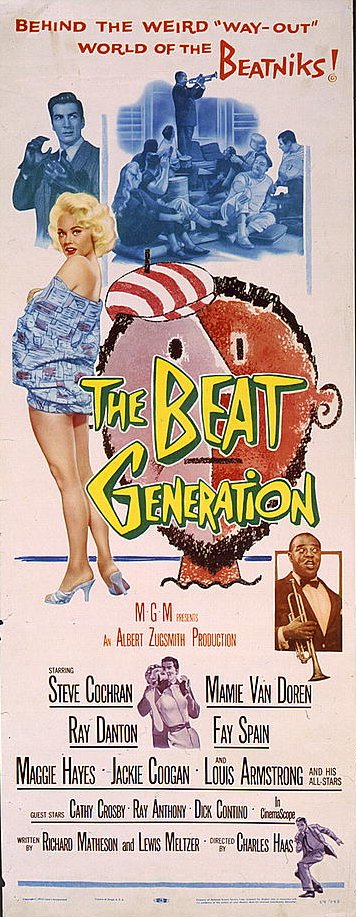
Postwar prosperity facilitated and was supported by a long postwar baby boom. From 1946 to 1964, the American population experienced an unprecedented spike. A century of declining birth rates abruptly reversed. After years of economic depression and the war, Americans were reunited and prosperous enough to support larger families, and had homes large enough to accommodate them. Women married younger and American culture celebrated the ideal of a large, nuclear family over the earlier ideal of extended families. Underlying this change was the new cult of professionalism that pervaded postwar American culture, including the professionalization of homemaking. Many Americans moved far from their family homes to pursue new educational and job opportunities, and mothers and fathers alike flocked to experts rather than family elders for guidance on marriage, sexuality, and, child-rearing. Psychiatrists held an almost mythic status as people took their opinions and prescriptions, as well as their vocabulary, into their everyday life. Books like Dr. Spock’s Baby and Child Care (1946) were diligently studied by women who thought of their work as housewife and mother as a career, complete with all the demands and professional trappings of job development and training. And since most women in new suburban neighborhoods had multiple children roughly the same age as their neighbors’ children, a cultural obsession with kids flourished throughout the era. A new youth focus dominated American popular culture. The anxieties of the atomic age hit America’s youth particularly hard and many embraced rebellion. The 1955 film Rebel Without a Cause demonstrated the restlessness of the postwar generation raised in increasing affluence yet unsatisfied with their comfortable lives. Young Americans also embraced rock ’n’ roll. They listened to Little Richard, Buddy Holly, and especially Elvis Presley, whose sexually suggestive hip movements were judged subversive by their parents.
Other Americans took larger steps to reject the expected conformity of the Affluent Society. The writers, poets, and musicians of the Beat Generation, disillusioned with capitalism, consumerism, and traditional gender roles, sought a deeper meaning in life. Beats traveled across the country, studied Eastern religions, and experimented with drugs, sex, and art. Some Americans challenged sexual mores. While the country proclaimed homosexuality a mental disorder, gay men established the Mattachine Society in Los Angeles and gay women formed the Daughters of Bilitis in San Francisco as support groups. Society’s “consensus,” on everything from the consumer economy to gender roles, did not go unchallenged. Much discontent was channeled through the machine itself, with advertisers selling rebellion no less than they sold baking soda. And yet others were rejecting the old ways, choosing new lifestyles, challenging old hierarchies, and embarking on new paths.
Questions for Discussion
- How did television influence Americans’ lifestyles and expectations?
- Why was the Baby Boom important?
Politics and Ideology
Postwar economic prosperity and the creation of new suburban spaces inevitably shaped American politics. In stark contrast to the Great Depression, the new prosperity renewed Americans’ belief in the superiority of capitalism, cultural conservatism, and religion. In the 1930s, the economic ravages of the international economic catastrophe had challenged the justifications for keeping government out of the economy. And yet pockets of true believers kept alive the gospel of the free market. The single most important was the National Association of Manufacturers (NAM). In the midst of the depression, NAM went on the offensive with advertising campaigns supporting “free enterprise” and “The American Way of Life.” Business leaders such as J. Howard Pew of Sun Oil and Jasper Crane of DuPont brought the message of free enterprise to the American people. One of the most important advocacy groups that sprang up after the war was Leonard Read’s Foundation for Economic Education (FEE). Read founded FEE in 1946 on the premise that “The American Way of Life” was essentially individualistic and that the best way to protect and promote that individualism was through libertarian economics. Libertarianism promoted individual liberty, property rights, and an economy with a minimum of government regulation. FEE, whose advisory board and supporters came mostly from the NAM network of Pew and Crane, became a key ideological factory, supplying businesses, service clubs, churches, schools, and universities with a steady stream of libertarian literature, much of it authored by Austrian economist Ludwig von Mises.
Shortly after FEE’s formation, Austrian economist and libertarian intellectual Friedrich Hayek founded the Mont Pelerin Society (MPS) in 1947. The MPS brought together libertarians from both sides of the Atlantic to challenge the Keynesian economics that had guided government fiscal and monetary policy during the New Deal. The Austrians believed that government involvement in the economy was a “slippery slope” leading to the types of totalitarian “command economies” the United States had been forced to fight in Europe and was facing in the USSR. University of Chicago economist Milton Friedman became MPS president. Friedman and his Chicago School of Economics became some of the most influential free market advocates in the world and helped legitimize for many the libertarian ideology so successfully evangelized by FEE, its descendant organizations, and libertarian popularizers such as Russian-American novelist Ayn Rand. Libertarian politics and evangelical religion combined to shape the ideology of a new conservative, suburban constituency. Suburban communities’ distance from government and other top-down community-building mechanisms left a social void that evangelical churches eagerly filled. More often than not the theology and ideology of these churches reinforced socially conservative views while simultaneously reinforcing a belief in economic individualism. Novelist Ayn Rand, meanwhile, whose novels The Fountainhead (1943) and Atlas Shrugged (1957) became two of the decades’ best sellers, helped push the ideas of individualism, “rational self-interest,” and “the virtue of selfishness” outside the halls of business and academia and into popular culture. Radical individualism became a building block for a new political movement, although it would take time to find a champion.
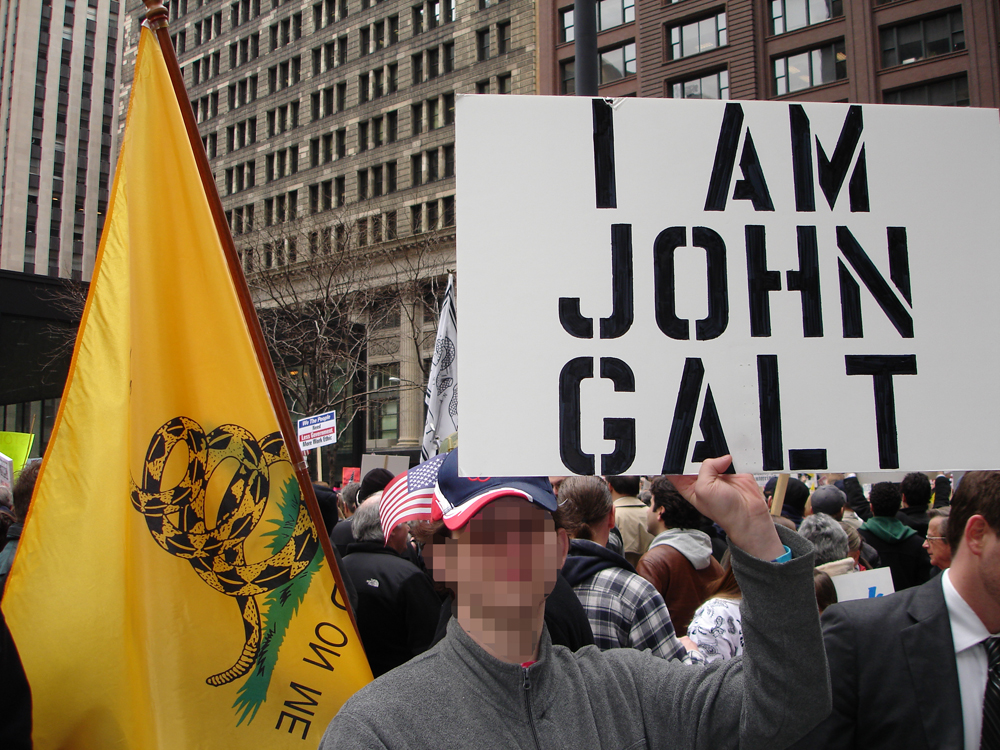
After World War II the Republican Party faced an important crossroad. Its dismal lack of electoral success since the Depression led to a battle within the party about how to revive itself. The more conservative faction was represented by Ohio senator Robert Taft (son of former president William Howard Taft) and backed by party activists and financiers such as J. Howard Pew. The conservatives sought to take the party further to the right, particularly in economic matters, by rolling back New Deal programs and policies. A more moderate “liberal” wing of the party, led by New York governor Thomas Dewey and Nelson Rockefeller (grandson of Standard Oil founder John D. Rockefeller), wanted to embrace and reform New Deal programs and policies. The Republican factions also disagreed about how involved the United States should be in the world. Issues such as foreign aid, collective security, and how best to fight communism divided the party.
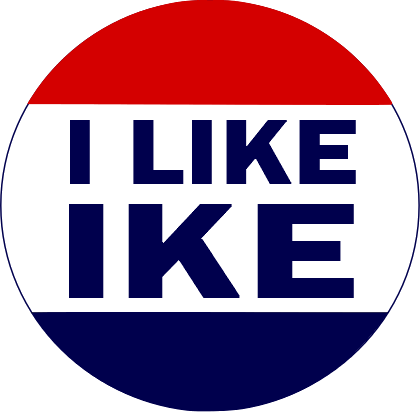
Initially, the “liberals,” won control of the party with the nomination of Thomas Dewey in 1948. Dewey’s shocking loss to Truman, however, emboldened conservatives, who rallied around Taft as the 1952 presidential primaries approached. With the conservative faction gaining power in the party, Dwight Eisenhower, the general who had led the allies on D-Day and most recently the NATO supreme commander, felt obliged to join the race in order to beat back the conservatives and “prevent one of our great two Parties from adopting a course which could lead to national suicide.” In addition to Eisenhower’s fear that Taft and the conservatives would undermine collective security arrangements such as NATO, he also disliked the “neanderthals” in his party for their anti–New Deal stance. Eisenhower felt that the best way to stop communism was to undercut its appeal by alleviating the conditions that made it most attractive. That meant supporting New Deal programs, NATO, and the Marshall Plan. The primary contest between Taft and Eisenhower was close and controversial. Taft supporters claimed that Eisenhower stole the nomination from Taft at the convention. To placate the conservatives in his party, Eisenhower picked California congressman and virulent anticommunist Richard Nixon as his running mate. Anti-communists like McCarthy campaigned for Eisenhower, who they saw as a potential ally. With the Republican nomination sewn up, the immensely popular Eisenhower swept to victory in the 1952 general election. Eisenhower’s popularity, captured in his campaign motto, “I like Ike”, boosted Republicans across the country, leading them to majorities in both houses of Congress. As previously mentioned, Republican legislative control allowed hard-liners like McCarthy to become chairmen of important committees, which increased the pressure toward conformity.

Ironically, the Republican sweep in the 1952 election translated into fewer than expected legislative accomplishments. Within two years of his election, the “liberal” Republican Eisenhower saw his legislative proposals routinely defeated by an unlikely alliance of conservative Republicans, who thought Eisenhower was going too far, and Democrats, who often thought he was not going far enough. For example, in 1954 Eisenhower proposed a national healthcare plan that would have increased coverage across the nation. The proposal was defeated in the house by a 238–134 vote with a swing bloc of seventy-five conservative Republicans joining Democrats to vote against the plan. Eisenhower’s proposals in education and agriculture often suffered similar defeats. By the end of his presidency, Ike’s domestic legislative achievements were largely limited to expanding social security; making Health, Education and Welfare (HEW) a cabinet position; passing the National Defense Education Act; and bolstering federal support to education, particularly in math and science. Eisenhower’s experience as a wartime general, however, caused him to surround himself with tough, decisive men like the Dulles brothers. John Foster Dulles became Secretary of State while his younger brother Allen became the longest-serving Director of Central Intelligence. At their urging, Eisenhower funneled money to anti-communist allies worldwide and allowed the CIA a free hand intervening in foreign governments. In 1952-3, the CIA collaborated with Britain’s MI-6 to overthrow the elected government of Iran. In 1954 the CIA organized a coup in Guatemala that installed a military dictatorship. Allen Dulles oversaw the CIA’s MKUltra mind-control experiments and helped organize Cuban counterrevolutionaries for what became known as the Bay of Pigs invasion. John and Allen Dulles’s state department and CIA also orchestrated a coup in Honduras that led to generations of civil conflict there, killing hundreds of thousands. Critics of the Dulles brothers accused them of manipulating Latin American diplomacy for the benefit of the United Fruit Company. John had been a partner at the international law firm that represented the company, and Allen was a member of its Board of Directors. The anti-communists in Eisenhower’s administration supported nationalist Taiwan against the new People’s Republic of China, rejected the previous policy of “containment” toward the Soviet Union and China, and formed the South East Asia Treaty Organization (SEATO) to try to prevent the spread of communism.
Questions for Discussion
- How did conservative economic thought spread?
- What was the relationship between this conservatism and U.S. foreign policy?
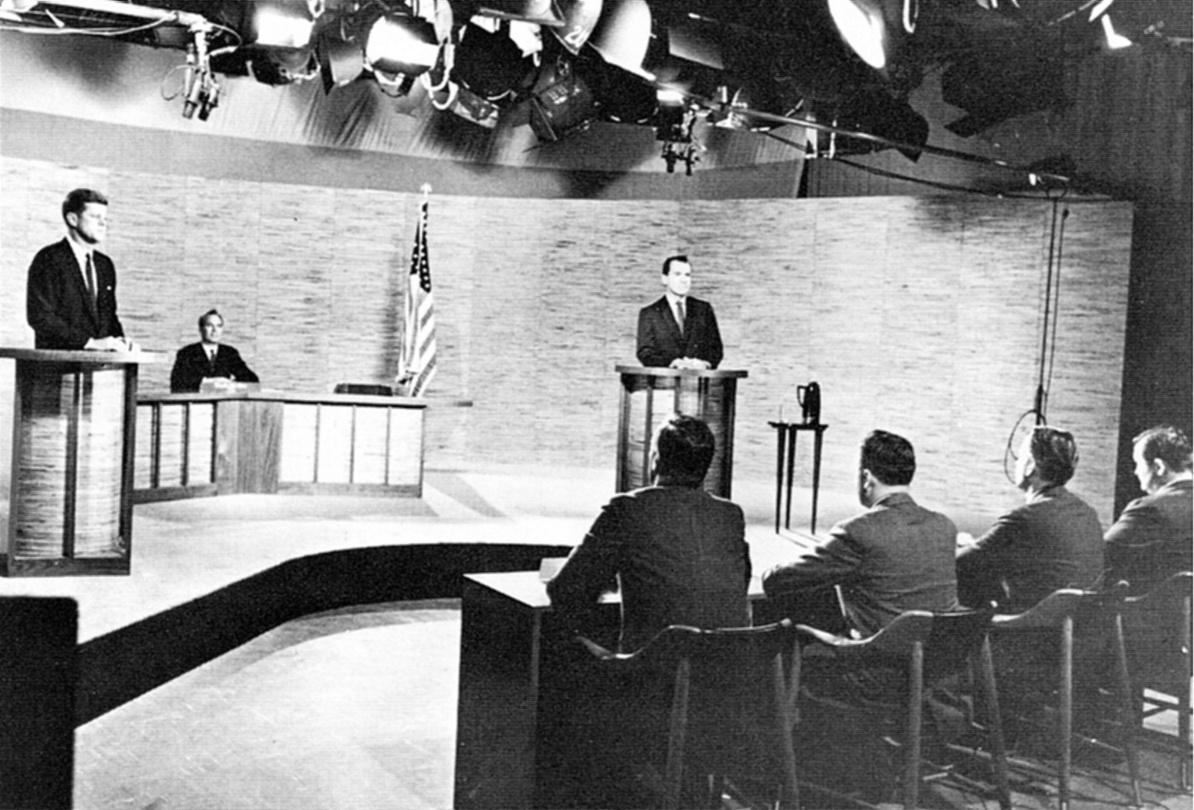
In 1960, Americans were captivated by a presidential race between Eisenhower’s vice president Richard Nixon and Democratic senator John F. Kennedy. Both candidates pledged to move the nation forward and reinvigorate an economy experiencing the first major recession since the Great Depression, proposing solutions that showed clearly differences between the parties. Kennedy promised to use federal programs to strengthen the economy and address pockets of longstanding poverty, while Nixon called for reliance on private enterprise and reduction of government spending. Both candidates faced suspicion and criticism as well: Nixon had to defend Dwight Eisenhower’s domestic policies, while the Catholic Kennedy had to counteract questions about his faith and convince voters that he was experienced enough to lead. Kennedy presented himself well in the first debate broadcast on television, and defeated Nixon by less than one percentage point in the popular vote. But Kennedy’s victory did not translate in Congress, where Democrats lost seats in both houses. The new president entered office in 1961 without the legislative support necessary to achieve the ambitious agenda he would refer to as the New Frontier.
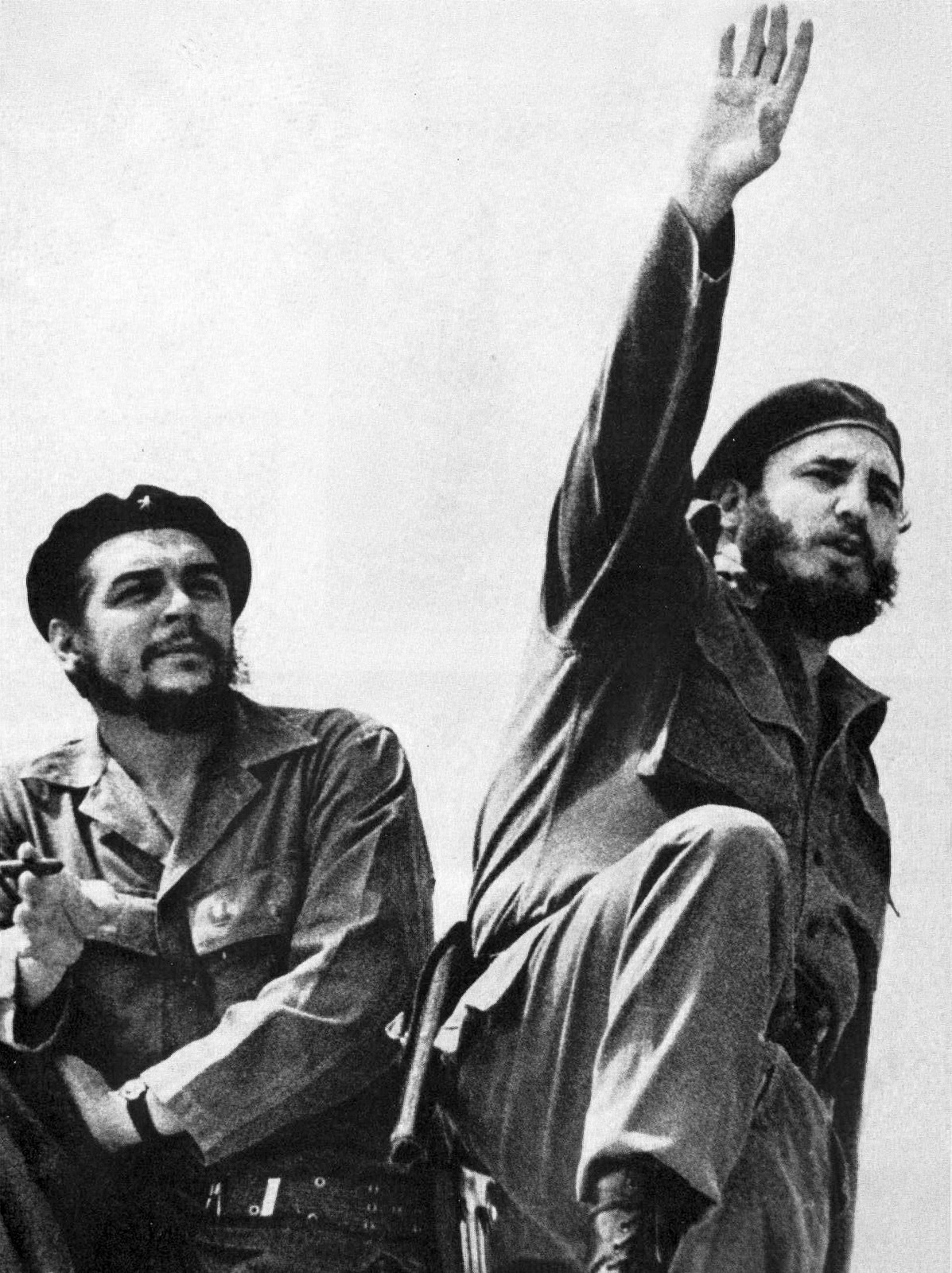
Kennedy also faced foreign policy challenges, including the consequences of previous U.S. foreign policy decisions. The United States had emerged from World War II as a global superpower and had begun a Cold War against the Soviet Union in the 1950s. In the new decade, unsuccessful conflicts in Cuba and Vietnam would yield embarrassment, fear, and tragedy, stunning a nation that expected triumph and altering the way many thought of America’s role in international affairs. In January 1959, Fidel and Raul Castro, Ernesto Guevara, and their revolutionary army ousted the corrupt Cuban president Fulgencio Batista. The United States, which had long supported Batista’s regime, initially expressed sympathy for Castro’s new government, which was immediately granted diplomatic recognition. But President Dwight Eisenhower and his advisors changed their position when the new Cuban government instituted leftist economic policies centered on agrarian reform, land redistribution, and the nationalization of private enterprises. Wealthy Cubans fled the island in droves. Many settled in Miami, Florida, and other American cities. In October 1960, just before the presidential election, the United States instituted a near-total trade embargo to economically isolate the Cuban regime and Allen Dulles began planning an invasion. The CIA began a series of attempts to assassinate Fidel Castro and in January 1961, the two nations broke off formal diplomatic relations. President Kennedy inherited these operations and allowed them to continue. On April 16, 1961, an invasion force of Cuban counterrevolutionaries landed at the Bay of Pigs but were quickly overwhelmed by Cuban troops and civilians. Thwarting the Bay of Pigs invasion legitimized the new regime and was a tremendous embarrassment for the Kennedy administration. As the Cuban embargo and assassination attempts continued, the Castro government became more closely aligned with the Soviet Union. In 1962, responding to the United States’ deployment of nuclear missiles in Turkey and at the invitation of the Cuban government, the Soviet Union sent nuclear missiles to Cuba. In October 1962, American spy planes detected the construction of missile launch sites, and President Kennedy went on TV to alert the American people to the threat of nuclear missiles aimed at America from 90 miles offshore. The world watched nervously as the United States and the Soviet Union hovered on the brink of nuclear war for a week. Finally, the Soviet Union agreed to remove its missiles from Cuba in exchange for a U.S. agreement to remove its missiles from Turkey and a formal pledge that the United States would not invade Cuba, and the crisis was resolved peacefully.
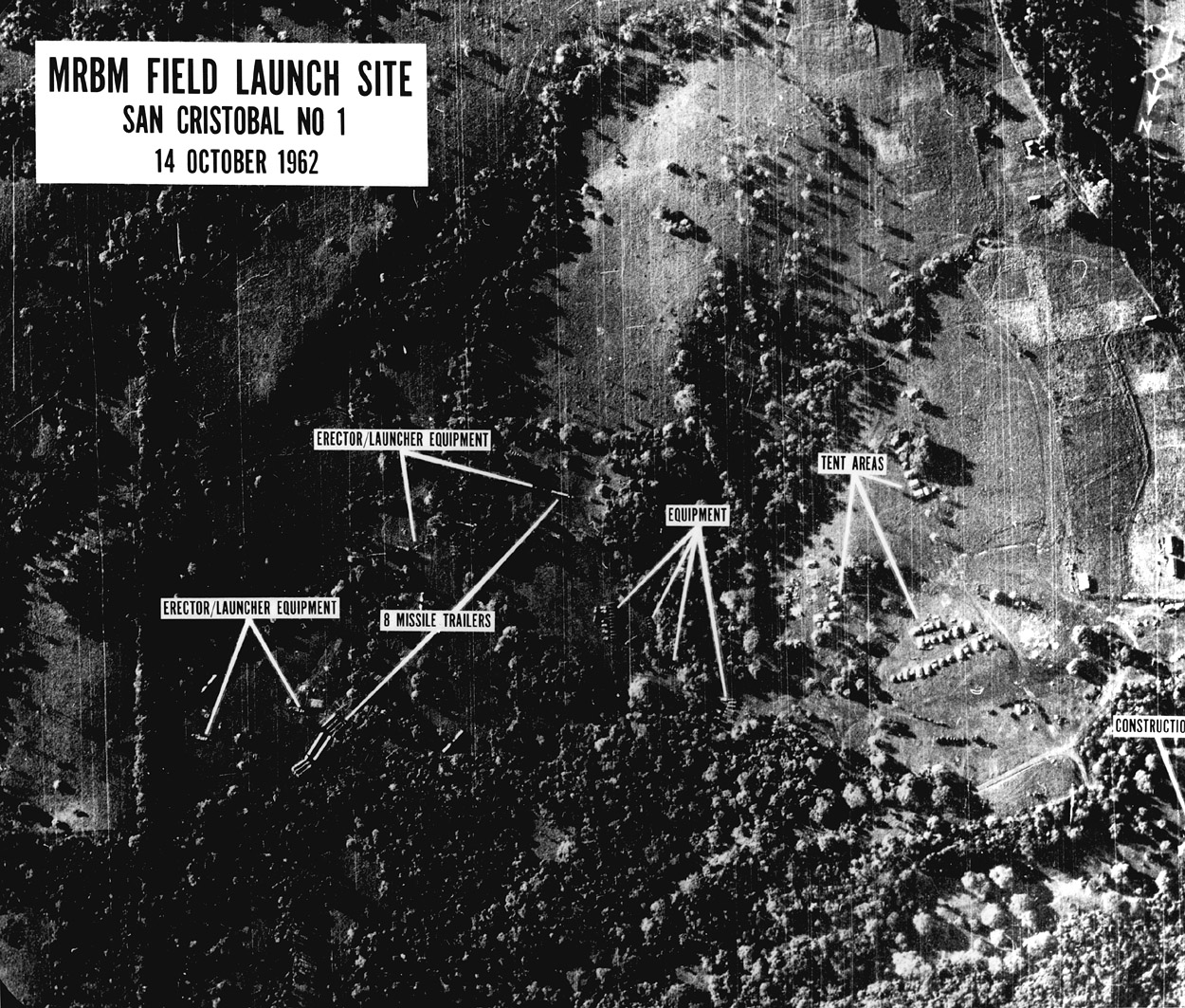
Question for Discussion
- How did the Kennedy administration’s reaction to the Cuban Missile Crisis affect the Cold War?
Civil Rights Continues
Much of the energy and character of the sixties emerged from the civil rights movement, which won many of its greatest victories in the early years of the decade. The movement itself was changing. Many of the civil rights activists pushing for school desegregation in the 1950s had been middle-class and middle-aged. In the 1960s, a new student movement arose whose members wanted swifter changes in the segregated South. Confrontational protests, marches, boycotts, and sit-ins accelerated. The year after the Greensboro sit-in had energized the thousands of high school and college students who launched the Student Non-violent Coordinating Committee (SNCC), civil rights advocates attempted a bolder variation of a sit-in when they participated in the Freedom Rides. Activists organized interstate bus rides to test the Supreme Court decision outlawing segregation on public buses and trains. The rides intended to force society to implement the court’s ruling, which many southern states had ignored. An interracial group of Freedom Riders boarded buses in Washington, D.C., with the intention of sitting in integrated patterns on the buses as they traveled through the Deep South. On the initial rides in May 1961, the riders encountered fierce resistance throughout the deep South. Angry white mobs attacked riders in Birmingham, burning one of the buses and beating the activists who escaped. Congressman John Lewis, a representative from Georgia, was brutally beaten when he entered a whites-only waiting room in Rock Hill, South Carolina. When they arrived in Jackson, Mississippi, the Freedom Riders were arrested and jailed. Additional Freedom Rides launched through the summer and generated national attention amid additional violent resistance. Ultimately, the Kennedy administration was forced to step in and direct the Interstate Commerce Commission to enforced integrated interstate buses and trains in November 1961.
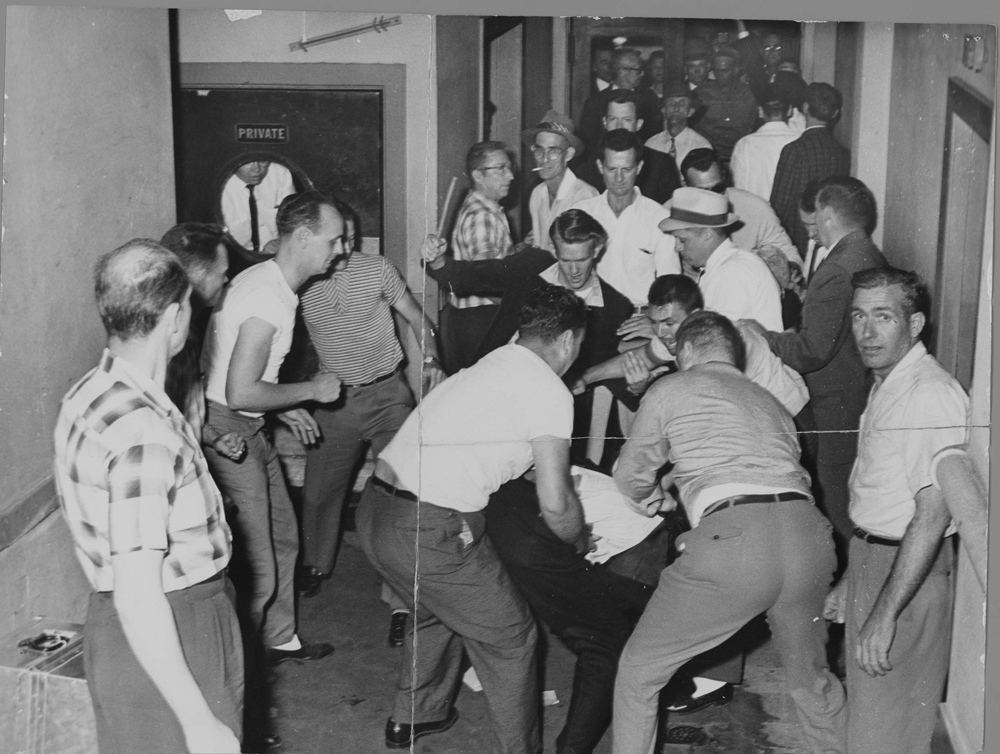
As the civil rights movement garnered more followers and more attention, white resistance stiffened. In October 1962, James Meredith became the first African American student to enroll at the University of Mississippi, sparking riots that prompted President Kennedy to send in U.S. Marshals and the National Guard to maintain order. Segregationists clashed with troops in the middle of campus, resulting in two deaths and hundreds of injuries. Violence served as a reminder of the strength of white resistance to the civil rights movement, particularly in the realm of education.
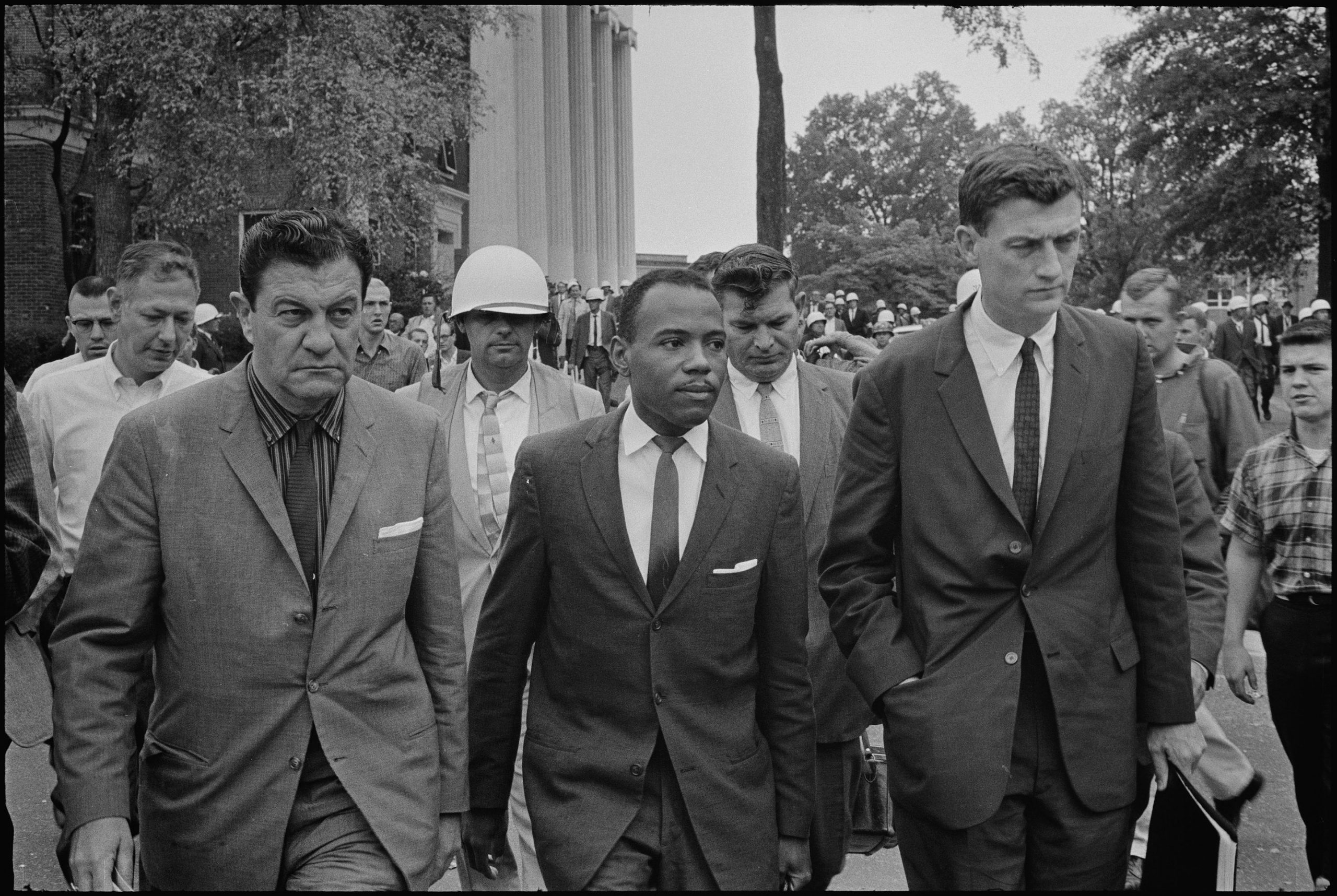
The following year, 1963, was perhaps the decade’s most eventful year for civil rights. In April and May, the SCLC organized the Birmingham Campaign, a broad program of direct action in Alabama’s largest city. Activists used business boycotts, sit-ins, and peaceful marches as part of the campaign. SCLC leader Martin Luther King Jr. was jailed and wrote the famous handwritten “Letter from the Birmingham Jail” urging not only his nonviolent approach but active confrontation to directly challenge injustice. The letter added to King’s national reputation and national coverage featured powerful photographs and video footage of white police officers using fire hoses and attack dogs on young African American protesters. It also yielded an agreement to desegregate public accommodations in the city. Activists in Birmingham won a victory for civil rights and drew international praise for the nonviolent approach in the face of police violence and vigilante bombings.
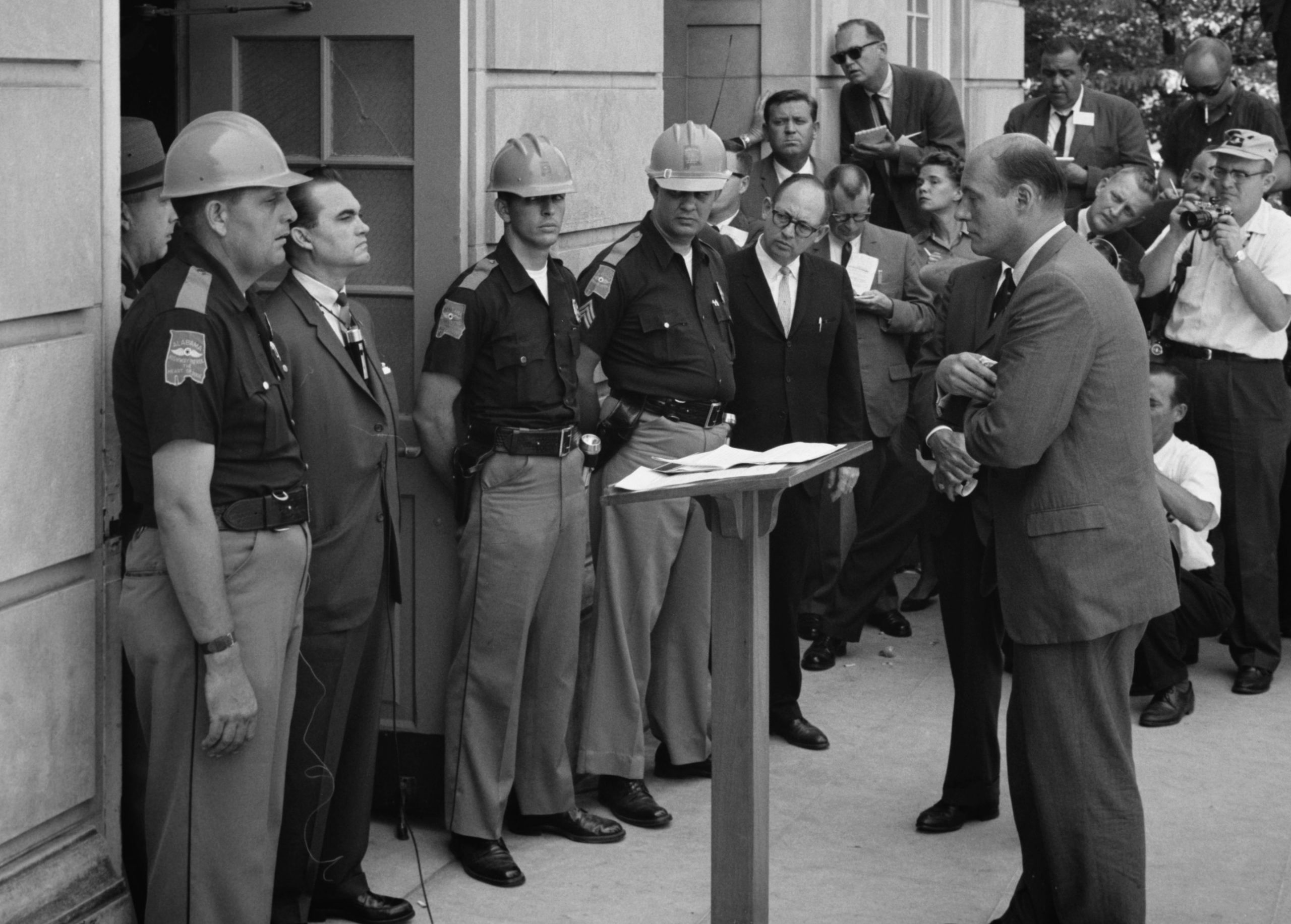
White resistance intensified. Conservatism maintained a strong presence on the American political scene. Few political figures in the decade embodied the working-class, conservative views held by millions of white Americans quite like George Wallace. The Alabama governor’s vocal stance on race was immortalized in his 1963 inaugural address when he shouted, “Segregation now, segregation tomorrow, segregation forever!” Just as the civil rights movement was gaining strength, Wallace became the champion of the many white southerners opposed to the movement. Wallace’s loud support of segregation earned him national recognition as a political figure willing to fight for what many southerners saw as their traditional way of life. In June 1963, just five months after becoming governor, Wallace famously stood in the doorway of Foster Auditorium to protest integration at the University of Alabama. President Kennedy addressed the nation that evening, criticizing Wallace and calling for a comprehensive civil rights bill. A day later, civil rights leader Medgar Evers was assassinated at his home in Jackson, Mississippi. In September, the KKK bombed a Birmingham church, killing four African American girls age 11 to 14.
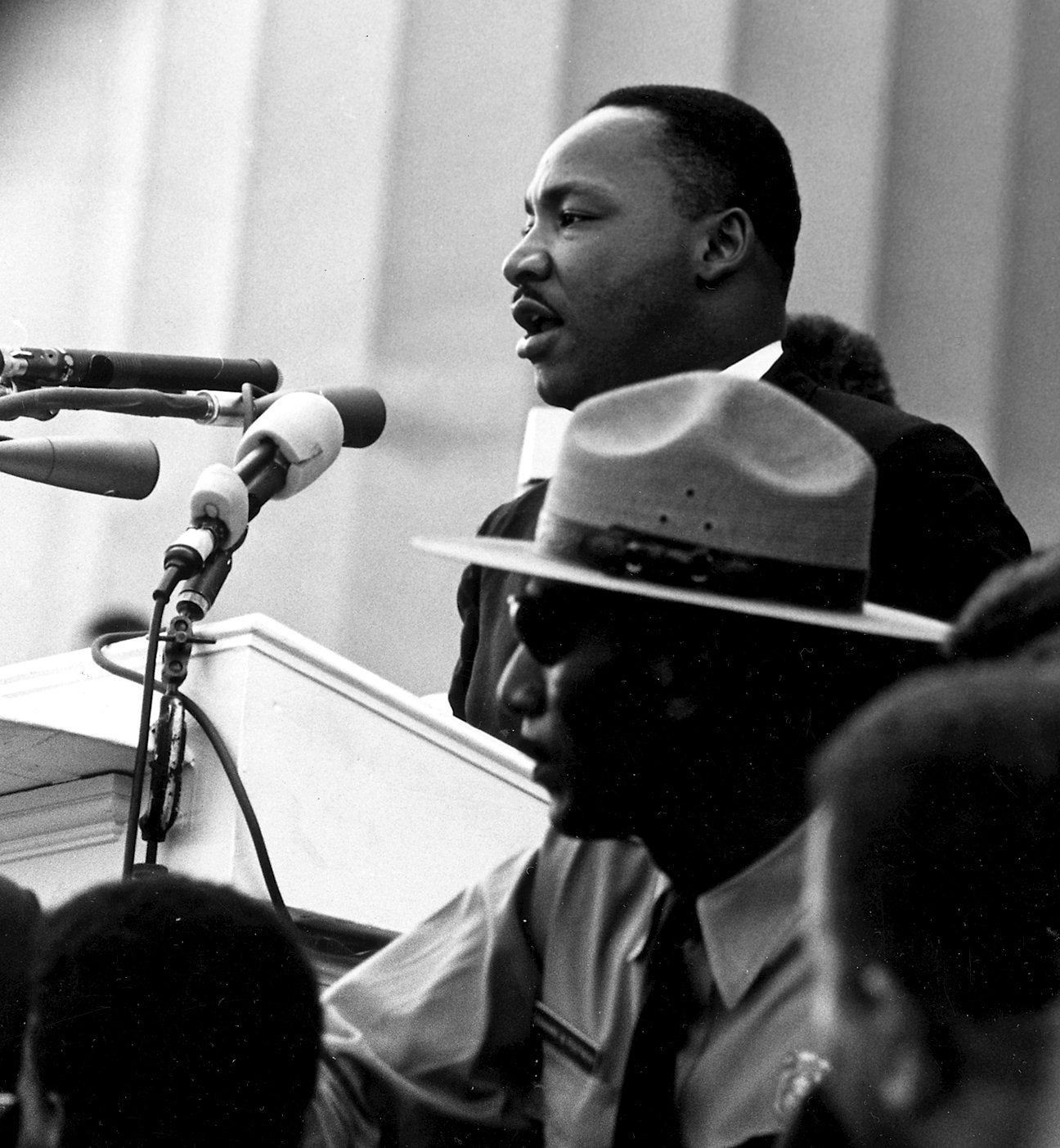
That summer, civil rights leaders organized a March on Washington. The August 1963 march called for civil rights legislation, school integration, an end to discrimination by public and private employers, job training for the unemployed, and a raise in the minimum wage. Over 250,000 people marched for civil rights. On the steps of the Lincoln Memorial, Martin Luther King Jr. delivered his famous “I Have a Dream” speech, raising the movement’s profile to new heights and putting unprecedented pressure on politicians to pass meaningful civil rights legislation.
Kennedy promised support for a civil rights bill, but southern resistance was intense and the bill stalled in Congress. Then, on November 22, 1963, President Kennedy was assassinated in Dallas. Vice President Lyndon Johnson lacked Kennedy’s youth, his charisma, and his popularity, but no one knew Washington better and no one before or since fought harder and more successfully to pass meaningful civil rights legislation. Raised in poverty in the Texas Hill Country, Johnson had entered politics during the Great Depression and had scratched and clawed his way up the political ladder. He was both ruthlessly ambitious and keenly conscious of poverty and injustice. He idolized Franklin Roosevelt whose New Deal had brought improvements for the impoverished central Texans Johnson grew up with.
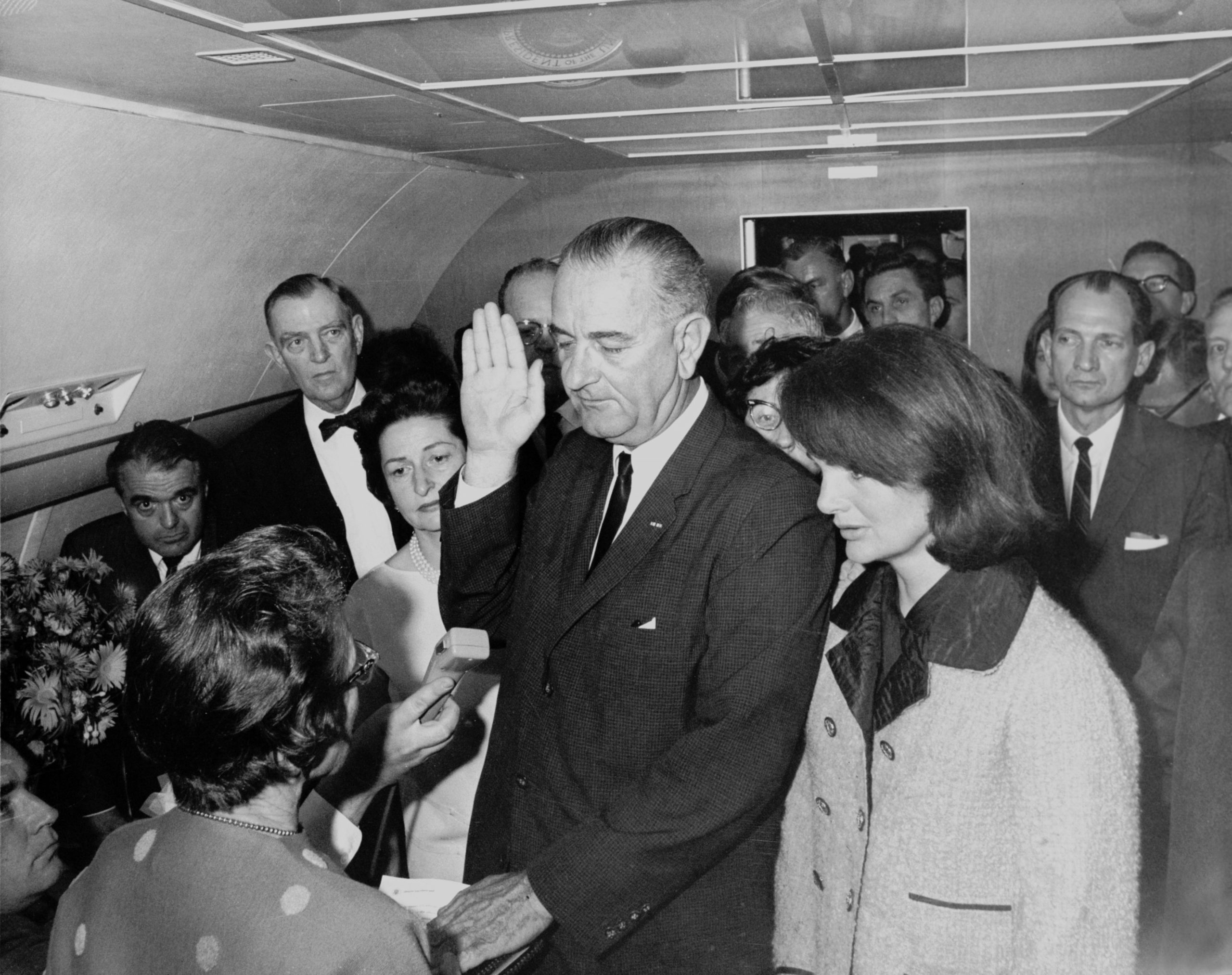
Question for Discussion
- What effect did the assassinations of Martin Luther King Jr. and John F. Kennedy have on American society?
Sources and References
This chapter was adapted from Chapter 26 and a bit of Chapter 27 in The American Yawp, with original additions by Dan Allosso. The original chapters were edited by James McKay and Samuel Abramson, with content contributions by Edwin C. Breeden, Aaron Cowan, Maggie Flamingo, Destin Jenkins, Kyle Livie, Jennifer Mandel, James McKay, Laura Redford, Ronny Regev, and Tanya Roth, Samuel Abramson, Marsha Barrett, Brent Cebul, Michell Chresfield, William Cossen, Jenifer Dodd, Michael Falcone, Leif Fredrickson, Jean-Paul de Guzman, Jordan Hill, William Kelly, Lucie Kyrova, Maria Montalvo, Emily Prifogle, Ansley Quiros, Tanya Roth, and Robert Thompson.
Brown v. Board of Education of Topeka (1954)
In 1896, the United States Supreme Court declared in Plessy v. Ferguson that the doctrine of “separate but equal” was constitutional. In 1954, the United States Supreme Court overturned that decision and declared that separate was never equal.
In 1959, photographer John Bledsoe captured this image of the crowd on the steps of the Arkansas state capitol building, protesting the federally mandated integration of Little Rock’s Central High School. This image shows how worries about desegregation were bound up with other concerns, such as the reach of communism and government power.
Redbook made this film to convince advertisers that the magazine would help them attract the white suburban consumers they desired. The “happy go spending, buy it now, young adults of today” are depicted by the film as flocking to the suburbs to escape global and urban turmoil. Redbook Magazine, “In The Suburbs” (1957). Via The Internet Archive.
Richard Nixon on the American Standard of Living (1959)
As Cold War tensions eased, exhibitions allowed for Americans and Soviets to survey the other’s culture and way of life. In 1959, the Russians held an exhibition in New York, and the Americans in Moscow. A videotaped discussion between Vice President Richard Nixon and Soviet Premier Nikita Kruschev, the so-called “Kitchen Debate,” won Richard Nixon acclaim at home for his articulate defense of the American standard of living. In the following extract from July 24, 1959, Nixon opened the American Exhibition in Moscow.
John F. Kennedy on the Separation of Church and State (1960)
American Anti-Catholicism had softened in the aftermath of World War II, but no Catholic had ever been elected president and Protestant Americans had long been suspicious of Catholic politicians when John F. Kennedy ran for the presidency in 1960. (Al Smith, the first Catholic presidential candidate, was roundly defeated in 1928 owing in large part to popular anti-Catholic prejudice). On September 12, 1960, Kennedy addressed the Greater Houston Ministerial Association and he not only allayed popular fears of his Catholic faith, he delivered a seminal statement on the separation of church and state.
Martin Luther King Jr., Letter from the Birmingham Jail (1963)
From the Birmingham jail, where he was imprisoned as a participant in nonviolent demonstrations against segregation, Dr. King wrote in longhand, in response to a public statement of concern and caution issued by eight white religious leaders of the South.
Martin Luther King Jr., “I Have a Dream…” (1963)
King gave his most memorable speech on August 28, 1963 on the steps of the Lincoln Memorial, during the March on Washington for Jobs and Freedom. A video of the speech is also available here.
Recommended Reading
- Boyle, Kevin. The UAW and the Heyday of American Liberalism, 1945–1968. Ithaca, NY: Cornell University Press, 1995.
- Branch, Taylor. Parting the Waters: America in the King Years, 1954–1963. New York: Simon and Schuster, 1988.
- ———. Pillar of Fire: America in the King Years, 1963–65. New York: Simon and Schuster, 1998.
- Brown, Kate. Plutopia: Nuclear Families, Atomic Cities, and the Great Soviet and American Plutonium Disasters. New York: Oxford University Press, 2013.
- Brick, Howard. The Age of Contradictions: American Thought and Culture in the 1960s. Ithaca, NY: Cornell University Press, 2000.
- Brown-Nagin, Tomiko. Courage to Dissent: Atlanta and the Long History of the Civil Rights Movement. New York: Oxford University Press, 2011.
- Carson, Clayborne. In Struggle: SNCC and the Black Awakening of the 1960s. Cambridge, MA: Harvard University Press, 1981.
- Chafe, William. Civilities and Civil Rights: Greensboro, North Carolina, and the Black Struggle for Freedom. New York: Oxford University Press, 1980.
- Cohen, Lizabeth. A Consumer’s Republic: The Politics of Mass Consumption in Postwar America. New York: Knopf, 2003.
- Coontz, Stephanie. The Way We Never Were: American Families and the Nostalgia Trap. New York: Basic Books, 1993.
- Dudziak, Mary. Cold War Civil Rights: Race and the Image of American Democracy. Princeton, NJ: Princeton University Press, 2002.
- Fried, Richard M. Nightmare in Red: The McCarthy Era in Perspective. New York: Oxford University Press, 1990.
- Gitlin, Todd. The Sixties: Years of Hope, Days of Rage. New York: Bantam Books, 1987.
- Grisinger, Joanna. The Unwieldy American State: Administrative Politics Since the New Deal. Cambridge, UK: Cambridge University Press, 2012.
- Hernández, Kelly Lytle. Migra! A History of the U.S. Border Patrol. Berkeley: University of California Press, 2010.
- Horowitz, Daniel. Betty Friedan and the Making of the Feminine Mystique: The American Left, the Cold War, and Modern Feminism. Amherst: University of Massachusetts Press, 1998.
- Isserman, Maurice. If I Had a Hammer: The Death of the Old Left and the Birth of the New Left. Champaign: University of Illinois Press, 1987.
- Jackson, Kenneth T. Crabgrass Frontier: The Suburbanization of the United States. New York: Oxford University Press, 1985.
- Jumonville, Neil. Critical Crossings: The New York Intellectuals in Postwar America. Berkeley: University of California Press, 1991.
- Levenstein, Lisa. A Movement Without Marches: African American Women and the Politics of Poverty in Postwar Philadelphia. Chapel Hill: University of North Carolina Press, 2009.
- May, Elaine Tyler. Homeward Bound: American Families in the Cold War Era. New York: Basic Books, 1988.
- McGirr, Lisa. Suburban Warriors: The Origins of the New American Right. Princeton, NJ: Princeton University Press, 2001.
- Ngai, Mae. Impossible Subjects: Illegal Aliens and the Making of Modern America. Princeton, NJ: Princeton University Press, 2003.
- Patterson, James T. America’s Struggle Against Poverty in the Twentieth Century. Cambridge, MA: Harvard University Press, 1981.
- Patterson, James T. Grand Expectations: The United States, 1945–1974. New York: Oxford University Press, 1996.
- Ransby, Barbara. Ella Baker and the Black Freedom Movement: A Radical Democratic Vision. Chapel Hill: University of North Carolina Press, 2000.
- Roberts, Gene, and Hank Klibanoff. The Race Beat: The Press, the Civil Rights Struggle, and the Awakening of a Nation. New York: Knopf, 2006.
- Self, Robert. American Babylon: Race and the Struggle for Postwar Oakland. Princeton, NJ: Princeton University Press, 2005.
- Sugrue, Thomas. The Origins of the Urban Crisis: Race and Inequality in Postwar Detroit. Princeton, NJ: Princeton University Press, 2005.
- Von Eschen, Penny. Satchmo Blows Up the World: Jazz Ambassadors Play the Cold War. Cambridge, MA: Harvard University Press, 2004.
- Wagnleitner, Reinhold. Coca-Colonization and the Cold War: The Cultural Mission of the United States in Austria After the Second World War. Chapel Hill: University of North Carolina Press, 1994.
- Wall, Wendy. Inventing the “American Way”: The Politics of Consensus from the New Deal to the Civil Rights Movement. New York: Oxford University Press, 2008.
- Whitfield, Stephen. The Culture of the Cold War. Baltimore: Johns Hopkins University Press, 1991.
Media Attributions
- 03124v © Thomas J. O'Halloran is licensed under a Public Domain license
- Toronto_Transit_Co._car_No._2438_(Queen-Woodbine),_Connaught_Ave._looking_south_from_Queen_Street © Ontario Safety League is licensed under a Public Domain license
- 5a25986v © Gottscho-Schleisner, Inc. is licensed under a Public Domain license
- Map_of_current_Interstates.svg © SPUI is licensed under a Public Domain license
- 2880px-AFL-CIO-seal.svg © AFL-CIO is licensed under a CC0 (Creative Commons Zero) license
- LevittownPA © Unknown is licensed under a Public Domain license
- Family_watching_television_1958 © Evert F. Baumgardner is licensed under a Public Domain license
- Home_Owners’_Loan_Corporation_Philadelphia_redlining_map © HOLC is licensed under a Public Domain license
- Little-Rock-TIME-1957 © Time Magazine is licensed under a Public Domain license
- Emmett_Till (1) © Mamie Till Bradley is licensed under a CC0 (Creative Commons Zero) license
- 2880px-Rosa_Parks_being_fingerprinted_by_Deputy_Sheriff_D.H._Lackey_after_being_arrested_on_February_22,_1956,_during_the_Montgomery_bus_boycott © Associated Press is licensed under a Public Domain license
- 2880px-Logo_SNCC.svg © SNCC is licensed under a Public Domain license
- I_Love_Lucy_1955 © CBS is licensed under a Public Domain license
- Cleaver_family_Leave_it_to_Beaver_1960 © ABC is licensed under a Public Domain license
- BeatGenerationLOC © Reynold Brown is licensed under a Public Domain license
- TDTP08 © HKDP is licensed under a CC BY-SA (Attribution ShareAlike) license
- I_Like_Ike_button,_1952 © Tyrol5 is licensed under a CC BY-SA (Attribution ShareAlike) license
- President_Eisenhower_and_John_Foster_Dulles_in_1956 © Unknown is licensed under a Public Domain license
- Kennedy_Nixon_Debat_(1960) © UPI is licensed under a Public Domain license
- CheyFidel © Alberto Korda is licensed under a Public Domain license
- Cuba_Missiles_Crisis_U-2_photo © Unknown is licensed under a Public Domain license
- Freedom_Riders_attacked © Tommy Langston is licensed under a Public Domain license
- James_Meredith_OleMiss © Marion S. Trikosko is licensed under a Public Domain license
- Wallace_at_University_of_Alabama_edit2 © Warren K. Leffler is licensed under a Public Domain license
- Martin_Luther_King_-_March_on_Washington © Rowland Scherman is licensed under a Public Domain license
- 2880px-Lyndon_B._Johnson_taking_the_oath_of_office,_November_1963 © Cecil W. Stoughton is licensed under a Public Domain license

